Revolutionize Your Multifamily Marketing Plan: Say Goodbye to Cold Calling
Cold calling has long been a staple in sales strategies, but in today’s multifamily marketing landscape, it’s becoming an outdated and inefficient approach. As buyers have more access to information than ever before, the days of the cold call, where you hope to reach a prospect who has never heard of your property, are increasingly behind us. Let’s explore why cold calling no longer works and how to shift your focus to a more effective multifamily marketing plan.
The Problem With Cold Calling Today
Today’s consumers have grown accustomed to controlling the flow of information. Prospects no longer want to receive unsolicited calls. Instead, they prefer researching their options online at their own pace. The internet allows multifamily buyers to gather information and form their opinions long before they engage in any form of direct communication.
This shift makes traditional cold calling less effective. Buyers can bypass sales pitches by finding answers to their questions online, and when they are ready to take action, they’re more likely to reach out to properties that have already built a relationship with them through strategic online content. This is where the power of content-driven marketing comes into play.

However, time and time again, we see industry professionals who cannot seem to shake the old-school approach. Something to keep in mind is that consumers are not the only ones with access to the internet. You can also use it to stay updated on your target customers’ issues and formulate ways to resolve them.
With access to robust market data and advanced tools, multifamily marketers now can engage prospects with content that aligns with their needs. By understanding your multifamily buyer persona and creating a multifamily brand story that resonates with them, you can generate warm leads that come to you, rather than having to interrupt them with a cold call.
As a commercial real estate marketing agency, we understand the power in numbers.
Content Is the New Cold Call
As much as outbound calls have been the cornerstone of many sales processes, inbound multifamily marketing offers a smarter way to engage prospects. With multifamily content marketing, your property can provide the information prospects need to make informed decisions. Inbound marketing attracts buyers by creating content that speaks directly to their needs and answers their questions before they ever pick up the phone.
Today, more than 75% of consumers say receiving customized content makes them more likely to consider a brand, and 78% are more likely to purchase after engaging with personalized communications. On the other hand, cold calling is a generic, one-size-fits-all approach that fails to meet the buyer where they are. Multifamily inbound strategies provide a more tailored experience, engaging prospects with relevant content that educates, informs, and builds trust.
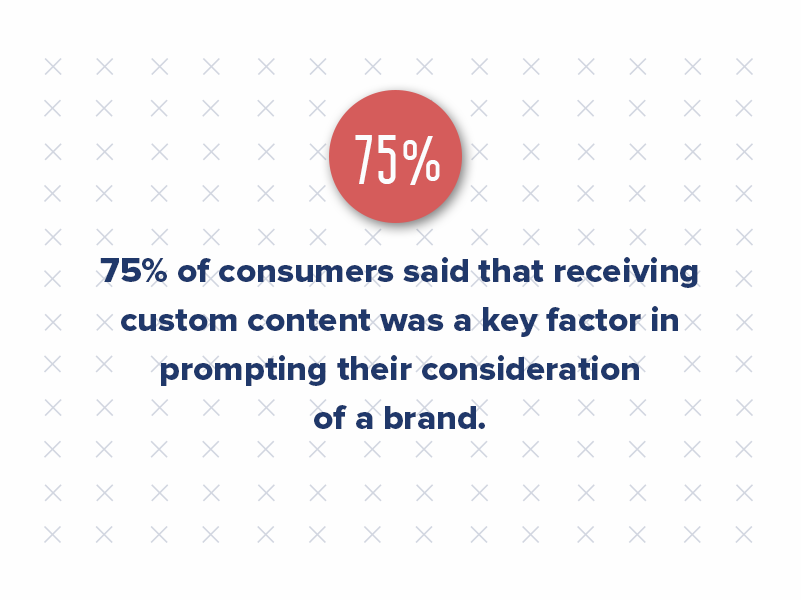
As a multifamily branding agency, we know that the effectiveness of marketing today relies on content that’s personalized and valuable. Instead of cold calling to persuade prospects to consider your property, you can bring them in with content that addresses their questions, pain points, and goals. From blog posts and white papers to video tours and social media engagement, multifamily branding done well serves as a tool to nurture leads before they ever reach out.
How to Shift Away From Cold Calling: 3 Effective Alternatives
So, how do multifamily marketers successfully build relationships without relying on the outdated practice of cold calling?
Here are a few strategies that can transform your sales approach and increase multifamily lead generation:
1. Network at Industry Events
Building relationships through networking is one of the most effective ways to grow your brand presence without the need for cold calling. Attending events like the National Apartment Association Apartmentalize or the Texas Apartment Association One Conference allows you to engage with other industry professionals and prospective clients.
Networking isn’t about pushing a sale but building trust and rapport. Establishing yourself as an authority in multifamily marketing can lead to speaking engagements, increased credibility, and more leads down the line.
2. Contribute Content to Relevant Publications
Content is a powerful asset in inbound multifamily marketing, and one of the most accessible avenues to build a sense of authority. Publishing articles, guides, and blog posts that answer common renter questions builds your multifamily brand identity and establishes you as an expert.
For example, creating content focused on your city’s “Best Neighborhoods for Young Professionals” or an in-depth guide to moving into an apartment helps foster a relationship with your audience. As your content becomes more aligned with what your multifamily buyer persona is looking for, you’ll see organic traffic rise, leading to more inbound leads without the need for cold calling.
Submit an article to a magazine publisher you know your customers will read, or create your blog. Furthermore, you don’t always have to publish your work. Reposting another blog by a reputable source will help gain attention and credibility.
At Criterion.B, our multifamily marketing plan includes guest posts and contributing articles to industry publications. If you take a quick look at our blog, you might notice a couple of guest posts now and then. These are relationships we are continually building. Our team also regularly publishes content for several publications, including the National Apartment Association, Texas Apartment Association, Units Magazine, Multifamily Insiders, and more.
3. Engage Past Customers and Build Relationships
A strong, organic way to grow your business is to focus on existing clients and encourage repeat business. The relationships you build will be at the core of your business. It’s as simple as that. Many of our most successful projects stem from previous clients who contacted us again after experiencing the value of our services. People are willing to pay a higher price when they know they are getting good service.
The multifamily brand story and brand experience you’ve built should continue to resonate with clients over time, keeping them engaged. Building relationships through consistent follow-ups, personalized emails, and providing value through updated services can keep your brand top-of-mind when they’re ready for more. While one customer might not have the budget, resources, or capabilities to become your customer right now, this could change in a year or two, so always keep that line of communication open.
Shifting Your Multifamily Marketing Plan for Success
As a multifamily marketing agency, we understand the need to adapt to an ever-changing digital landscape and adjust your multifamily marketing plan. While cold calling once worked, the modern approach requires a strategic shift toward multifamily inbound marketing. The days of purely relying on outbound efforts are fading as more prospects expect to research and decide based on the content you create. Whether through blog posts, SEO-optimized websites, social media campaigns, or email marketing, the focus is on nurturing relationships, providing valuable insights, and meeting prospects where they are.
With multifamily branding, it’s about creating content that not only speaks to renters’ needs but builds trust and establishes authority in the industry. Once your property has built up a reputation through consistent, engaging content, your multifamily marketing plan becomes less about selling and more about building a genuine relationship with your customers. Through multifamily graphic design, your property can create a compelling online experience that connects with prospective renters on a deeper level.
In the long run, shifting your focus to inbound strategies and moving away from cold calling will lead to more engaged prospects, stronger relationships, and a more sustainable approach to multifamily marketing. The key is creating a unique brand that resonates with your audience and using the right digital marketing tools to amplify your reach and connect with prospective renters before they even need to make a call.
Remember, it doesn’t matter which multifamily marketing plan or strategy you use as long as you treat the customer with the utmost importance.
How AI Is Changing SEO in Multifamily Marketing
The rules of search marketing are changing under our feet. Imagine a prospective renter asking ChatGPT (not Google) to recommend the best apartment community in your city. Will your property even appear in that AI-generated answer?

In an era of generative AI and fragmented search behavior, multifamily marketing executives face tough questions. Can you trust algorithms with your brand’s story? Who holds authority when AI can generate content on the fly? And with renters finding apartments via TikTok, Instagram, or voice assistants, how do you measure marketing impact when traditional Google Analytics might not capture the whole picture?
These aren’t hypothetical questions; they’re strategic dilemmas CEOs, COOs, and Marketing Directors in the multifamily industry must contend with right now.
Welcome to the new SEO reality, where Google is still critical but no longer the only game in town.
The Rise of Search-Everywhere Optimization
Not long ago, “SEO” was practically synonymous with “Google SEO.” Today, that’s no longer the case. Renters (especially younger ones) increasingly turn to alternative discovery platforms, forcing multifamily marketers to optimize for search everywhere, not just Google.
In fact, Google’s own research found that nearly 40% of Gen Z prefers using TikTok or Instagram for search instead of Google. Instagram has now risen to the second-largest search platform globally, reflecting a dramatic diversification in search behavior. From social media hashtags to YouTube tutorials to Reddit threads, people are finding information (including apartments and local recommendations) in many places that never show up in Google Analytics.
To put things in perspective, Google still leads in traditional search engine usage, but even that dominance is starting to waver. In 2023, Google’s search engine market share dipped below 90% for the first time in a decade.
And if you broaden the definition of “search” to include all platforms, some analyses peg Google at only about 18.8% of global search activity. The rest is happening on platforms like TikTok, Instagram, YouTube, Amazon, Snapchat, voice assistants, and now AI chatbots.
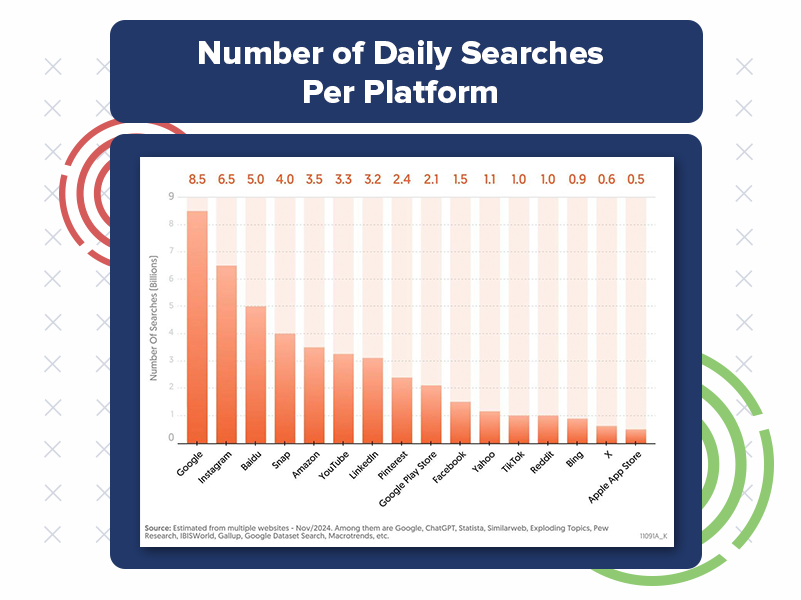
In other words, SEO strategies can’t rely solely on Google anymore. This is the advent of “search-everywhere optimization,” where the goal is to make your content visible wherever your audience might be searching.
For multifamily marketers, this shift is huge. Prospective renters might discover your property through an Instagram neighborhood tour, a TikTok video of your amenities, a question answered on Reddit, or a query to Alexa or Siri. They might even ask ChatGPT or another AI assistant for “the best pet-friendly apartments in {City}” and get an AI overview of options.
If your marketing strategy is focused only on ranking in Google’s search results, you risk missing swaths of these prospects. The “new SEO” means embracing a fragmented ecosystem and crafting content that’s optimized for multiple search engines and social platforms.
Practically, this could involve:
- Social SEO: Optimizing your social media profiles and posts with keywords (yes, people search within social apps). For example, ensuring your Instagram captions include local neighborhood terms or amenities can help you appear in Instagram search results. TikTok SEO is also a real thing; savvy brands are including spoken keywords in their TikTok videos and text overlays so that TikTok’s algorithm surfaces them.
- Visual Search: Recognizing that renters often search visually. Instagram and TikTok are essentially visual search engines. A strong visual content strategy (high-quality photos, short videos, virtual tours) optimized with the right tags and descriptions can capture those searchers.
- Alternative Platforms: Don’t forget platforms like YouTube (for longer video content), Pinterest (for apartment decor inspiration searches), and even voice search on smart speakers. The rise of voice search is notable — 58% of consumers have used voice search to find local business information, like nearby apartments. If someone asks a voice assistant about your property, will it have the information (and reviews) needed to recommend you?
The bottom line: your multifamily marketing plan must treat SEO as broader “search everywhere” optimization. It’s about meeting potential renters on their terms, whether that’s a Google query, a social media search, or an AI chatbot conversation. The future of SEO lies in embracing this multi-platform reality and ensuring your brand is present and persuasive across all of it.
Hype vs. Reality: AI-Driven Search Traffic in 2025
Of course, no conversation about the future of search is complete without talking about generative AI tools like ChatGPT. Over the past two years, we’ve heard countless predictions that AI chatbots will revolutionize search and siphon traffic away from traditional search engines. Some multifamily marketers might be wondering if “ChatGPT SEO” is now a thing, and whether they should be optimizing content for AI referrals. The truth requires cutting through some hype.
There’s no doubt that ChatGPT’s usage has skyrocketed. OpenAI’s ChatGPT reached over 400 million weekly users by early 2025, an astonishing adoption rate. And indeed, websites have started seeing traffic coming from ChatGPT’s citations. In fact, referrals to publisher websites from ChatGPT have grown eightfold in the span of six months.
But before we declare the death of Google, let’s look at the actual impact: even after an 8x surge, AI-driven search traffic still accounts for less than 0.1% of total visits for those sites.
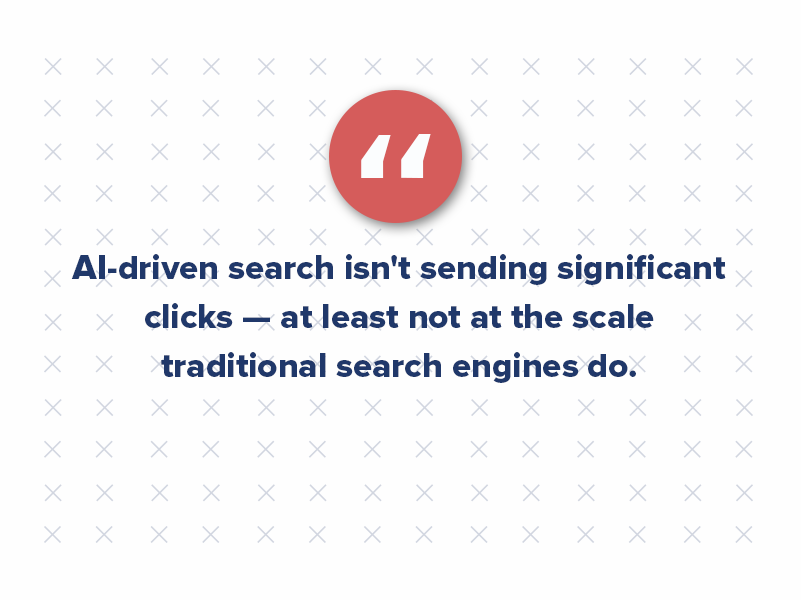
In other words, 99.9% of traffic is still coming from traditional channels. ChatGPT might be sending a trickle of extra visitors, but it’s nowhere near replacing Google, direct traffic, or even social media referrals in volume.
ChatGPT’s popularity doesn’t (yet) equal massive web traffic. Despite the buzz, ChatGPT referral traffic is still a tiny slice of the pie for most websites.
For example, fourteen leading news publishers received a combined 3.5 million visits from ChatGPT in one month — sounds great, until you realize those sites had 3.8 billion total visits that month. That’s why AI-driven search made up under 0.1% of traffic. This gap between hype and reality is critical as you plan your 2025 SEO strategy.
Yes, you should watch ChatGPT and similar AI platforms, but don’t bet the farm on them just yet. Why is AI referral traffic so small despite the huge usage of tools like ChatGPT? The fundamental issue is user behavior. Generative AI tools often answer questions directly on their own platform, without sending the user to an external site.
If a renter asks ChatGPT, “What are some good apartments in Downtown Seattle?”, ChatGPT might generate an answer drawing from various sources (and cite those sources). The user gets a convenient summary right there in the chat interface. They might not feel the need to click through to every source cited.

In essence, AI-driven search encourages “zero-click” results even more than Google does — the answer is delivered in full, which is great for user convenience but not so great for your website’s traffic. Publishers and brands are essentially training AI models with their content, and not always getting the click credit back.
So what does this mean for you as a multifamily marketer? Calibrate your expectations. Don’t ignore AI search (it’s growing fast, and those numbers could change), but don’t panic either. Google is still the primary source of SEO traffic for now, with social and direct channels also crucial. Consider AI chatbots as additional discovery tools — if ChatGPT or Bing Chat can cite your content, it’s another way to build brand awareness.
For instance, an AI answer might mention your property or quote your blog post about renting tips, planting a seed in the user’s mind. But that click may never show up in your analytics, so success might look different (brand mentions, not just site sessions).
A savvy SEO strategy keeps one foot grounded in reality and one foot testing the waters of emerging tech. Continue to invest in traditional SEO and content marketing strategies that drive organic traffic (more on that below), while also experimenting with optimizing content for AI. This could mean ensuring your content is well-structured and factual so AI models find it credible and worth citing. It might also mean using schema markup or FAQs on your site that could be pulled into AI answers.

Just remember: AI-driven search is a supplement, not a substitute — at least for now. The worst thing a marketing leader could do is chase the shiny object (AI) at the expense of the proven channels that still deliver 99% of your leads.
Smarter or Just Louder? Generative AI’s Impact on Content Quality
One of the promises of generative AI is that it can make content creation lightning-fast. Thanks to tools like ChatGPT, marketers can now produce blog posts, social captions, and even video scripts in a fraction of the time it used to take.
But this raises a pivotal question: Is generative AI making content smarter, or just making the internet louder? Quantity has skyrocketed — quality, not so much. As an executive overseeing multifamily marketing, it’s critical to discern whether AI is actually improving your content strategy or just adding to the noise.
Let’s face it: AI-generated content has exploded in recent years. It’s never been easier to spin up 1,000-word articles on any topic under the sun. Need 50 variations of a property description for SEO? An AI can give you that in seconds.
But there’s a catch: AI can only regurgitate what’s already out there. As one industry expert aptly asked, is AI content just repackaging existing information?
In many cases, yes. Generative models predict plausible text based on their training data — they don’t generate new knowledge. If everyone in your market is using the same AI tools trained on the same data, you’ll all end up publishing eerily similar, surface-level content.
The result? A deluge of blogs and pages that add volume but not unique value. Content gets louder, but not smarter. On the other hand, original research and insights are the antidote to AI noise.
When your brand produces content based on unique data — say, a proprietary survey of renters, an analysis of your leasing trends, or a case study from your portfolio — you’re creating something AI can’t replicate (at least until it trains on your content!).
Original, data-driven content marketing gives you fresh statistics, novel perspectives, and specific expertise that stand out in search results. It establishes you as a thought leader with true authority, rather than just another content mill.
While generative AI in marketing can boost efficiency, original research remains the key to true authority. In other words, to build brand authority in SEO, you still need human intelligence and creativity behind your content.
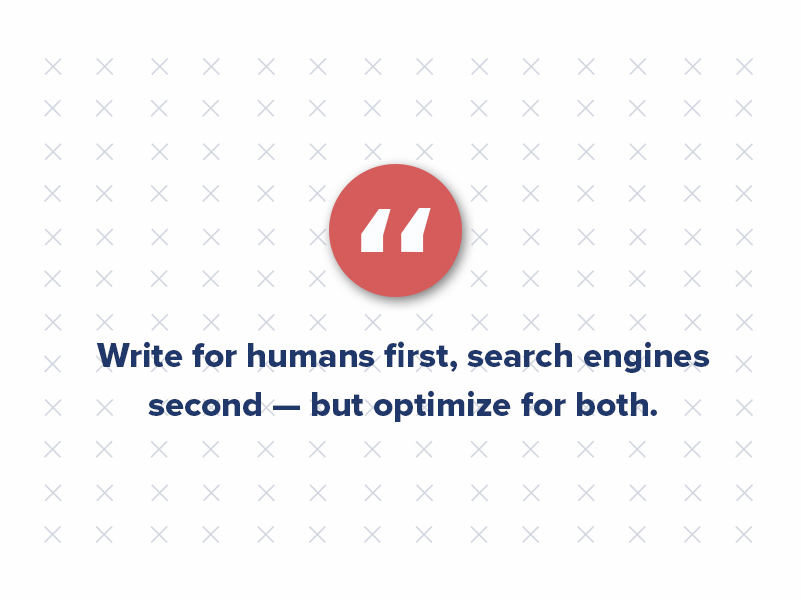
Consider this scenario: A regional property management firm decides to publish a “2025 Renter Preferences Report,” drawing on their internal resident surveys and local market data. They uncover, for example, that 68% of their prospects prioritize commute time over rent price (a hypothetical finding). They publish this report and an accompanying blog post with the data. This kind of original research in SEO is gold — dozens of other sites might quote it, bloggers will link to it, and it gives Google something truly new to chew on.
Meanwhile, a competitor down the road churns out ten AI-written articles like “Top 10 Apartment Amenities” that say nothing readers haven’t already seen. Which content will earn more backlinks, social shares, and trust? The one with original, data-driven insight. As one marketing leader put it, “AI can summarize existing data, but it can’t generate new insights.”
Brands that invest in creating those new insights will dominate search in the long run. This isn’t to entirely dismiss AI’s role. Generative AI is a fantastic tool for productivity — it can help draft outlines, rewrite sections for tone, or generate ideas. It’s being integrated into content marketing strategies everywhere. Use it for the grunt work, by all means. But don’t outsource your expertise.
The best approach is a hybrid one: leverage AI for efficiency, but infuse your content with the human touch, industry experience, and original data that only you can provide.
Think of AI as your copywriting assistant, not your strategist. The brands that win will be those who pair AI’s speed with human strategy and original research. That’s how you create content that’s not just more content, but better content. And one more word to the wise on this topic: transparency. Audiences are becoming savvy about AI-generated content, and some are wary of it.
A recent survey found 94% of consumers believe AI content should be disclosed, and 46% are less likely to trust a brand that doesn’t disclose AI-generated content. This means authenticity is part of content quality, too. If you do use AI in creating content, consider being upfront about it or at least ensure it passes a high bar of quality and fact-checking.
In the end, content that is honest, insightful, and truly useful will rise above the noise, no matter how it’s produced.
The Human Touch: Why User-Generated Content Still Matters
Amid all this talk of AI, it’s easy to forget a simple truth: people trust people. In the multifamily business, leasing is a very human decision — someone is choosing their next home. All the slick AI content in the world can’t replicate the authenticity of a real resident’s opinion or a genuine human voice. That’s why user-generated content (UGC) has become more vital than ever for SEO and marketing performance.
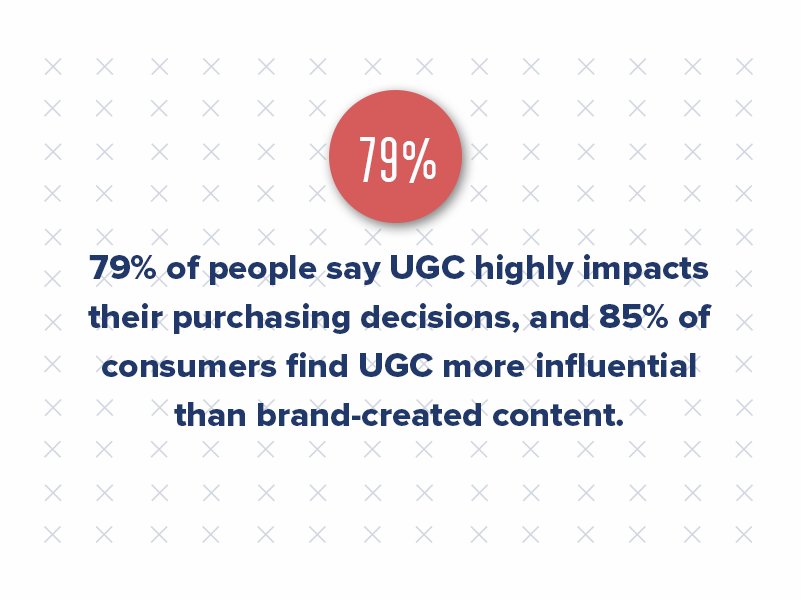
In fact, in a landscape increasingly flooded with AI-produced text and stock marketing copy, the human touch might be your biggest differentiator. Consider these telling statistics: 79% of people say UGC highly impacts their purchasing decisions, and 85% find UGC more influential than brand-created content.
In other words, if someone is on the fence about your apartment community, they’re far more likely to be swayed by a resident’s Instagram post or a review on Apartments.com than by your polished brochure copy. This makes sense — UGC is seen as more authentic because it is more authentic. It’s the digital word-of-mouth. Renters trust the lived experiences of other renters over a corporate website every time.
And notably, this isn’t just a consumer gut feeling; it translates into SEO performance as well. Google’s algorithm itself now prioritizes content like customer reviews, Q&A forum discussions, and social proof in search results.
When someone searches for “Best apartments in Uptown” or “{Your Property} reviews,” Google often showcases UGC (i.e., the star ratings, the review snippets, the questions people ask on Google Maps) right at the top of results.
Authentic voices carry weight. It’s no wonder Google has evolved to surface user-generated content prominently. Reviews and community-driven discussions signal trust and relevance.
And as of 2025, social media algorithms are also favoring UGC more than ever. Instagram and TikTok have tweaked their platforms to push authentic, community posts to the forefront of feeds.
A resident’s raw, unscripted TikTok tour of an apartment can go viral overnight, whereas a slick professional video might get ignored. The takeaway: UGC isn’t just “nice to have” — it’s a cornerstone of modern SEO and brand trust. So, how can multifamily marketers harness the power of UGC?
First, encourage your residents to create content. This could be as simple as running an Instagram hashtag contest for the best balcony garden photos in your community, or asking for testimonials to feature on your website. Every genuine review, rating, and social mention contributes to your “digital footprint” in search. Prospective renters often Google “[Your Property] reviews” — make sure there’s something positive for them to find. Even negative reviews, when responded to sincerely, can boost trust (and yes, engagement on those review pages helps SEO too).
Second, integrate UGC into your own content. Showcase real resident stories on your blog. Include quotes from testimonials in your email marketing. Curate social media posts by residents and share them (with permission). Far from ceding control of your message, this approach builds credibility. As marketing experts point out, brands that harness UGC see higher engagement and better conversions because consumers crave authenticity.
Google knows this — engagement and time-on-page are ranking signals. A heartfelt video testimonial might keep a prospect on your site longer (helping SEO) than a generic AI-written paragraph.
Finally, note that UGC can fill content gaps that your team might not even think of. Residents will discuss things in reviews and forums that aren’t on your radar — maybe praising the dog park during winter, or noting that the on-site gym gets crowded at 6 pm. These bits of information often contain keywords and long-tail phrases future renters search for (“dog-friendly apartments with winter facilities” or “apartment gym peak hours”).
By facilitating and listening to UGC, you indirectly boost your SEO for those niche queries, too. In a time when AI content is everywhere, UGC stands out as real, unscripted, and trustworthy. It’s content that AI can’t fake.
Make it a part of your strategy: encourage it, amplify it, respond to it. Not only will you earn renters’ trust, but you’ll also please the search engines by providing the kind of content they know users want to see.

Featured Snippets Are Fading: Enter Answer Engine Optimization (AEO)
If you’ve been keeping an eye on your Google traffic over the past year, you might have noticed something curious: those once-coveted featured snippets (the answer boxes at the top of search results) are showing up less often for your keywords. And when they do appear, they might be grabbing the answer and yielding fewer clicks to your site.
What’s happening?
In a word: evolution.
Google is transitioning from a “search engine” into more of an “answer engine,” especially with the rollout of its AI-driven features. For multifamily marketers, this means it’s time to pivot from traditional snippet-focused SEO to Answer Engine Optimization (AEO).
First, let’s talk about the decline of the featured snippet. Several recent studies have shown a significant drop in the prevalence of featured snippets on Google since late 2024. In one analysis, the number of queries that yielded a featured snippet fell by 35% between September 2024 and March 2025.
In some niches, the decline was even more dramatic — another dataset showed a 57% drop in snippet occurrence over that period for a set of tracked queries.
The culprit? Google’s new AI-generated answers (often called “AI overviews” in Search Labs) are starting to replace the traditional snippet in many cases.
Instead of a single website excerpt getting the spotlight, Google’s AI might generate a multi-source summary for the user’s query. Even when featured snippets do appear, their ability to drive clicks has diminished. Why? Because if the answer is right on the page, users have less reason to click through.
Recent research by Ahrefs compared search results with and without Google’s new AI overview present. The findings were sobering: when an AI overview was shown, the click-through rate (CTR) of the top organic result plummeted from about 7.3% to 2.6%.
That’s a massive drop in traffic for the site that technically “ranks #1.” In percentage terms, one study noted a 34.5% reduction in organic CTR for top pages when Google’s AI overview was in play.
Essentially, the AI answer is siphoning off clicks that would have gone to the organic results — a trend similar to how old featured snippets sometimes led to “zero-click searches,” but now on steroids. Google’s own CEO has claimed that AI overviews could improve engagement, but early data contradicts that.
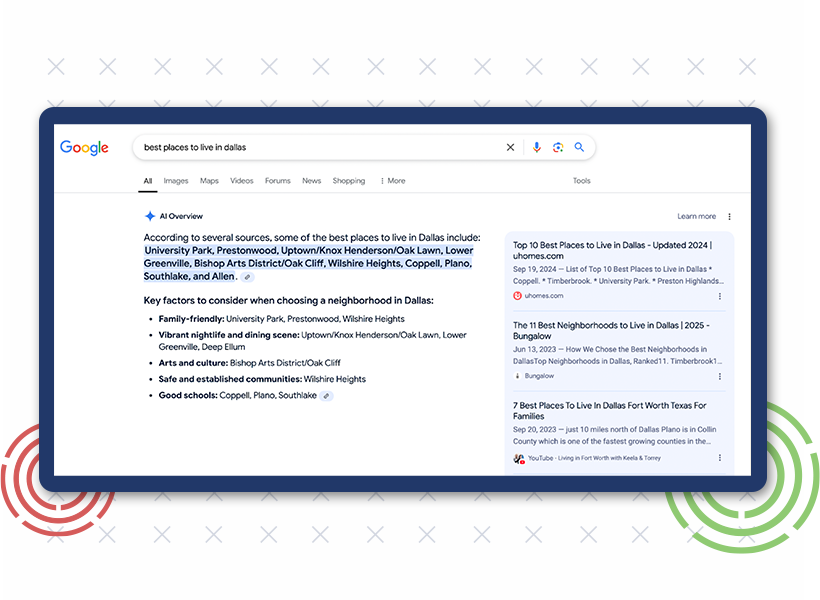
For marketers, this means that even if you maintain your rankings, you might see less traffic coming from those rankings if Google decides to answer the query on the SERP itself.
So, are featured snippets dying? It appears they’re certainly losing prominence. But the need to be the source of answers is not dying — it’s just shifting. This is where Answer Engine Optimization (AEO) comes in. AEO is the practice of optimizing your content specifically to serve as direct answers in these new paradigms.
Rather than just aiming for Rank #1 in a list of blue links, you’re aiming to be the answer that the search engine (or voice assistant, or chatbot) delivers to the user. It’s an evolution of traditional SEO, recognizing that more searches are happening in an answer-oriented context (think Google’s AI summaries, Siri’s spoken answers, Alexa’s responses, etc.).
What does AEO involve? In many ways, it builds on good SEO practices but with extra structure and clarity. Key tactics include:
- Provide Concise, Structured Answers: For common renter questions (e.g. “What amenities do luxury apartments have?” or “How much is the average rent in Uptown?”), make sure your content provides a clear, succinct answer. Use headings, bullet points, and schema markup (like FAQ schema) to signal the structure. AEO is about giving the algorithms exactly what they need to extract a direct answer. If you have a blog post titled “10 Questions to Ask When Renting an Apartment,” you might format it so each question is a header followed by a brief answer. This increases your chances of being pulled into a featured snippet or voice answer box.
- Optimize for Voice Search Phrases: Voice queries tend to be conversational and often phrased as questions or commands (“find me an apartment near the park with 2 bedrooms”). 58% of consumers use voice search for local business info, so it’s crucial to mirror that language in your content. This might mean incorporating Q&A-style content on your site. Think about the exact phrases a renter might speak into Siri or Alexa, and make sure those phrases (or close variations) appear in your copy. AEO and voice search optimization go hand-in-hand.
- Maintain Fast, Mobile-friendly, and Context-rich content: This hasn’t changed – the technical side of SEO (speed, mobile UX, meta tags) still matters for AEO. But additionally, context matters. For instance, if someone asks, “Which apartments in my area have dog parks?”, an AI-powered engine might favor content that directly addresses pet-friendly apartments in that specific area. Ensure you have hyper-local content and that your Google Business Profile, NAP (Name, Address, Phone) data, and local schema are all up to date. That way, if an answer engine is picking “best apartments near [neighborhood]”, your data helps put you in the mix.
- Focus on Intent and Accuracy: AEO is unforgiving to fluff. If your content doesn’t directly answer the user’s intent, it likely won’t be used by an answer engine. During content planning, identify the core intent behind keywords. For example, someone searching “apartment lease guarantor” likely wants to know what a guarantor is and how it works. AEO-oriented content on that topic should jump straight into an explanation, not beat around the bush. And accuracy is paramount – if answer engines find a more authoritative or precise answer elsewhere (or worse, if your content is wrong), you’re out. This is where having original research and clear sources can help (a nice overlap with the previous section). If you can cite a statistic or provide a fact no one else has, you become the authority the answer engine trusts.
It’s worth noting that AEO doesn’t replace traditional SEO; it augments it. You still want to rank well in the regular results, because not every search has an answer box, and many users still scroll. But AEO recognizes that the top-of-page real estate is evolving.

We’re headed toward a search results page that might have an AI summary at the top (with citations), followed by maybe one featured snippet or knowledge panel, and then the list of links. And in voice search, there is often only one answer given. It’s a winner-takes-all scenario. That’s why securing that answer spot can deliver outsized rewards.
Forward-thinking multifamily marketers should start treating AEO as an essential part of their SEO strategy. Answer Engine Optimization means thinking beyond “How do I rank #1 for [keyword]?” to “How do I become the trusted answer for questions my audience is asking?” It’s a shift in mindset from pure keywords to user questions and intents.
![Forward-thinking multifamily marketers should start treating AEO as an essential part of their SEO strategy. Answer Engine Optimization means thinking beyond “How do I rank #1 for [keyword]?” to “How do I become the trusted answer for questions my audience is asking?” It’s a shift in mindset from pure keywords to user questions and intents.](https://criterionb.com/wp-content/uploads/2025/06/Generative-AI-and-SEO-Call-Out-4.jpg)
In practice, this might mean creating more FAQ pages, writing more how-to guides and Q&A style blogs, and using tools like Google’s “People Also Ask” and Bing’s chat queries to research what questions are being asked. If featured snippets are indeed on the decline, then capturing that Answer Engine position (whether on Google SGE, a voice assistant, or an AI chat) is the next big prize.
Google’s SGE: What It Is and How to Adapt
By now, you’ve likely heard of Google’s Search Generative Experience (SGE) — Google’s bold experiment to infuse generative AI into the search results page. For multifamily marketers, SGE is one of the most important developments to watch, as it could fundamentally change how your prospective renters interact with search. Let’s break down what SGE is, how it’s reshaping search, and what you should do to stay ahead.
What is SGE? In simple terms, SGE is Google’s effort to provide AI-generated answers within Google Search itself. Instead of just showing the usual list of blue links, Google can now generate a rich answer at the top of the results for certain queries. This AI-powered summary might include text, bullet points, images, and citations with links to the sources. The idea is to give users a deeper, more intuitive result, especially for complex queries.
For example, a user could type a broad question like “What are the best neighborhoods for young professionals in Dallas with affordable rent?” and SGE would produce a concise overview: perhaps mentioning three neighborhoods, highlighting a couple key stats or insights for each (drawn from various websites), and then suggesting some next follow-up questions. It’s search meets AI meets a bit of a chat-like experience. Google says SGE aims to help people ask more nuanced questions, grasp topics faster with AI summaries, and even accomplish tasks directly from the search interface.
You might have seen examples where SGE can do things like draft an email or generate an image if prompted, though for most search marketing purposes, it’s the Q&A summary that matters. At its core, SGE represents Google’s response to the chatbots (ChatGPT, Bing Chat) that were threatening to upend traditional search. Google is basically saying: “We can do that too, right on our search page.”
Now, how does SGE reshape the search results page (SERP)? From what we’ve observed in beta tests and rolling updates, when SGE is activated for a query, it typically occupies the top of the SERP with a colorful background, spanning the width of the page. The traditional ads and search results get pushed further down. The SGE answer often provides a few key points and then perhaps 3-5 links as citations or “next steps” for the user to click if they want more detail.
In effect, it can function like a super-featured snippet. For multifamily, imagine a query like “Luxury apartments vs budget apartments differences” — SGE might display a short comparison table or list, citing an article that you (hopefully) wrote. The critical impact here is on visibility and clicks. If your content is one of the cited sources in an SGE answer, your brand gets visible at the top in the context of that answer, which is great for exposure.
However, the user might get a lot of info from the AI summary itself, meaning they might not click your link even if you’re cited. SGE, therefore, shifts some visibility from traditional organic results to AI-generated summaries.
If your content isn’t part of those summaries, you risk losing out on traffic and awareness. As one SEO expert put it, this change “changes the game for multifamily marketers” — if your site isn’t optimized to appear in SGE responses, you could be invisible to a segment of searchers. Traditional SEO principles still apply, but they must be expanded to account for how AI curates content.

So, what should multifamily marketers do to adapt to SGE? Here are a few strategies:
- Keep Creating High-Quality, In-Depth Content: This point cannot be overstated. SGE tends to pull from top-ranking, authoritative content to build its answers. Google isn’t inventing information; it’s synthesizing from the best of what it finds. That means your content still needs to earn its way to the top. Comprehensive guides, helpful blog posts, and resource pages that thoroughly answer renters’ questions stand a better chance of being included in SGE summaries. For instance, a well-researched blog on “10 Tips for First-Time Renters” that gains traction could be what SGE pulls from when someone asks a related question. Continue to prioritize original research and expertise as discussed earlier — those qualities make your content more likely to be seen as authoritative. In short, content depth and value matter even more now.
- Optimize for Conversational Queries: With SGE (and AI chat in general), we expect more users to type queries in a natural, question form. They might treat Google a bit like ChatGPT, using complete sentences or very specific questions. Adjust your SEO keyword research to include these long-tail, conversational queries. Consider adding an FAQ section to relevant pages addressing those questions (e.g., “What’s it like living in [Neighborhood]?” or “How do I budget for my first apartment?”). Being optimized for these nuanced questions increases your chances of getting picked up by SGE’s algorithms.
- Ensure You’re Technically AI-Friendly: This is new territory, but early indications are that proper schema markup (like FAQ schema, HowTo schema, etc.), clear headings, and well-structured content can help AI better understand and extract your content. Also, continue following E-E-A-T guidelines (Experience, Expertise, Authoritativeness, Trustworthiness) — Google’s AI is likely tuned to favor content from sources that demonstrate these qualities. For multifamily firms, this means showcasing your expertise (e.g., through author bios, case studies, and citing trustworthy data). If SGE is picking which site’s info to trust in an answer, you want to signal “we know our stuff and can be trusted.”
- Leverage Local SEO for SGE: Multifamily marketing is inherently local. SGE has shown improvements in handling local search queries — for example, “apartments near Central Park under $3k.” Make sure your local SEO is airtight: update your Google Business Profile with complete info and fresh photos, gather Google reviews (which both help traditional SEO and might influence AI results for local intent), and include localized content on your site. If there are common local questions (e.g., “Is [Neighborhood] safe for families?”), consider addressing those on your blog. SGE will likely use data from Google Maps, reviews, and local content when answering location-based questions, so be present in those data sources.
- Monitor and Measure: Start looking at your analytics and Google Search Console data for signs of SGE’s impact. Google is beginning to report when content is shown in AI overviews. You might see impressions for queries where you were cited by SGE without a click. Keep an eye on overall organic traffic and click-through rates on your top queries. If you notice drops that coincide with SGE’s rollout, that might prompt you to double down on AEO tactics or content updates. Conversely, if you see spikes in impressions but not clicks, that could indicate your content is being surfaced in SGE answers. It’s a new kind of metric to wrap your head around: being “visible” even without a click. We might need to start valuing that exposure in a similar way to how we view, say, a billboard impression — it has branding value even if it doesn’t drive an immediate click.
It’s important to remember that SGE is still an experiment. Google is testing and refining it, and it’s not yet available to all users as of this writing. There’s been both excitement and pushback; some users love the new AI answers, others find them confusing or worry about inaccuracies. Google will undoubtedly tweak the feature over time. Maybe SGE becomes the new norm; maybe it gets dialed back.
Regardless, the trend is clear: search results are becoming richer and more AI-driven. As a multifamily marketing leader, staying informed and agile is your best play. In summary, treat SGE as both a challenge and an opportunity.
- The challenge: your content now has to compete in an AI-curated space and not just the old 10 blue links.
- The opportunity: if you can land your content as part of an SGE answer, you gain prime visibility and the halo effect of being “what Google itself summarized.” Adapt your SEO strategy with SGE in mind, and you’ll be positioning your brand for the next generation of search.
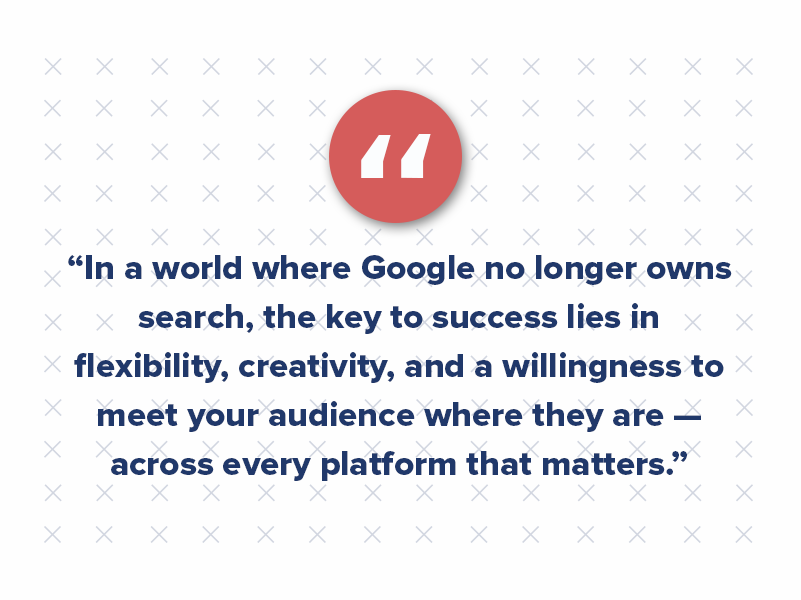
Back to the Basics: The Era of New SEO
The search and content landscape for multifamily marketing is undergoing its most profound shift in decades. Generative AI, alternative search platforms, and evolving user behaviors are rewriting the rules that many of us grew comfortable with. As an executive, it’s easy to feel a bit of uncertainty (or even skepticism) amid all the rapid change. But within this upheaval lies opportunity.
The key is to embrace the change strategically, without losing sight of timeless marketing truths. If there’s one theme that emerges from examining these trends, it’s a sort of “back to basics” by way of the future.
Yes, the tools and platforms are changing — from Google’s SGE, to TikTok search, to ChatGPT referrals — but what those algorithms and users ultimately seek remains consistent: relevance, value, and trust. In a world where AI can generate content by the ton, originality and authenticity become your trump cards.
For multifamily marketers, the mandate is clear: diversify and double down. Diversify your SEO approach beyond Google — optimize for that “search-everywhere” reality where renters might find you on Instagram, YouTube, or an AI assistant as much as on a SERP. But double down on what makes your brand stand out — your unique expertise, your data, your community of residents (who can advocate for you), and your human touch.
Practically, this means your marketing team’s playbook for the next 12 months might include actions like these:
- Conduct a Content Audit for Originality: Review your blog, website, and social content. How much of it is saying the exact same thing as your competitors (or what an AI could scrape together)? Identify places to inject original research in SEO content — perhaps commissioning a renter survey, analyzing your internal data for trends (e.g., “move-in rates are highest in Q3” or “pet owners stay 6 months longer on average”), or creating interactive content (like a rent calculator or neighborhood quiz). This original content will not only engage readers but also earn backlinks and citations that improve your Google SEO and even your presence in AI summaries.
- Build a UGC and Community Strategy: Make it easy and rewarding for your residents to leave reviews, share on social, and participate in testimonials. This might involve reputation management software or simply more active community management on your part. Remember, every star rating and review snippet can bolster your brand authority in SEO by signaling trust to algorithms (and humans!). As we saw, authenticity is king, and your residents can speak to that better than anyone.
- Train Your Team (and Yourself) on AI: Rather than fearing AI tools, empower your marketing team to use them wisely. AI can assist with keyword research (e.g., using ChatGPT to brainstorm question variants people might ask), help repurpose content (turn a blog post into a tweet thread or a video script), and handle mundane tasks — freeing your humans to focus on strategy and creativity. Establish guidelines for AI-generated content to ensure it meets your quality standards and is transparent. By weaving AI into your workflows, you stay efficient and signal that your organization is forward-thinking.
- Stay Educated on SEO Developments: The pace of change in search marketing is blistering. What Google rolls out this month might change by next quarter. Consider allocating time for your team to follow SEO news or even engage with SEO communities. When Google makes a major change (like an SGE update or an algorithm tweak), have a quick internal review of how it might affect your properties’ web traffic and lead flow. In short, keep your finger on the pulse. The companies that adapt fastest often gain a competitive edge.
- Refocus on Metrics that Matter: Lastly, rethink how you measure marketing impact in this new era. Traditional metrics like organic traffic and click-through rate are still important, but we might need to add new KPIs to the dashboard. For example, if zero-click searches rise, you might track “brand visibility” — such as how often your brand appears in search results or is mentioned by AI, even if a click doesn’t occur. You might track engagement on social platforms as part of SEO success (since those platforms drive search discovery). And of course, bottom-line metrics like lead volume, conversion rate, and occupancy rate remain the ultimate judges of success. Ensure that even as you try new approaches, you tie your efforts back to tangible business outcomes (leases signed, inquiries, tours booked). Upper management will appreciate that you’re innovating and staying accountable to results.
Navigating this new SEO landscape requires a blend of openness and steadfastness. Be open to the new: new platforms, new techniques, new consumer habits. Experiment with that TikTok idea, test a voice-search optimized FAQ, explore a partnership with local influencers, or try a pilot using AI for a content series. But remain steadfast in your commitment to your brand’s core value proposition and authenticity.
Technology will continue to evolve, but the fundamental need for trust and authority in marketing does not change. Generative AI and Google’s evolving search might reshape how SEO is done, but they don’t change why SEO is done — to connect your offering with the people who need it, in the moments they are searching.
The path forward is to adapt boldly while carrying forward the lessons of what truly resonates with renters. Do this, and you won’t just survive the changing SEO game; you’ll lead it, human touch and all, into the future of multifamily marketing.

A Simple Shift That Boosted Sales by 9.5% + How It Can Work for Leasing
Imagine increasing lease conversions and rental revenue without cutting prices, adding amenities, or reworking your multifamily marketing budget.
Sounds too good to be true, right?
But that’s exactly what McDonald’s pulled off with a small yet powerful pricing psychology experiment — and it’s a game-changer that multifamily operators can apply to leasing strategies.
In 2023, McDonald’s made a subtle but brilliant change to how it presented pricing on its menu boards. No discounts, no promotions — just a tweak in how customers saw pricing. The result? A 9.5% increase in global sales and higher average order values.
What does that have to do with multifamily leasing? Everything.
McDonald’s proved that pricing isn’t just about the number — it’s about perception. And in an industry where renters are highly price-sensitive, understanding pricing psychology could be the competitive edge you need.

The Hidden Pain of Pricing — And How to Minimize It
Studies in Neural Computing have found that seeing a currency symbol (like “$”) activates the same brain regions associated with pain. In short, money spent hurts.
That’s why high-end restaurants often ditch the “$” sign, displaying a dish as “18” instead of “$18.” McDonald’s took this concept mainstream with a few key tweaks:
- They moved the price below the item description so customers saw what they wanted before seeing the cost.
- They removed currency symbols to reduce subconscious “pain” when purchasing.
- They increased image sizes by 40% to enhance desire and decrease price sensitivity.
- They highlighted best-sellers to leverage social proof and speed up decision-making.
- The psychology behind this? Desire first, cost second. Customers are more likely to commit when they see what they want before seeing the price.
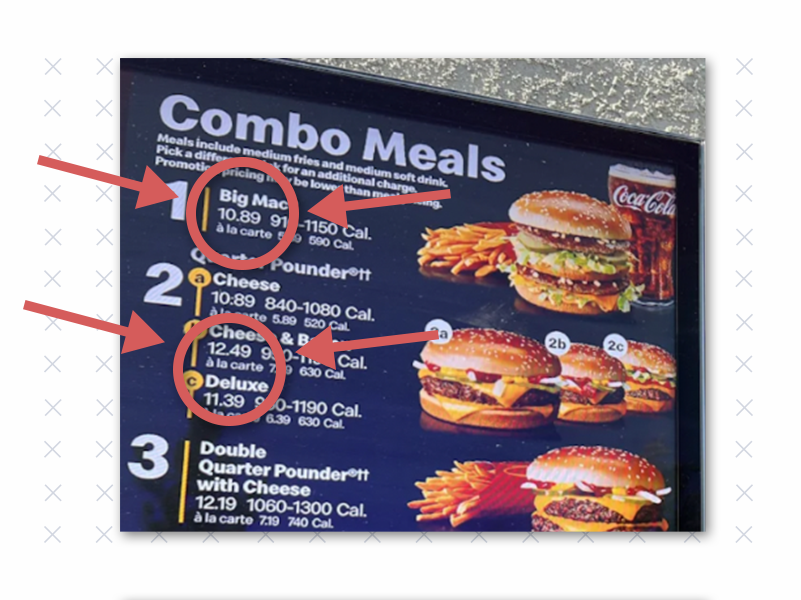
How Multifamily Can Apply This to Leasing
Most apartment websites and leasing strategies unintentionally trigger price sensitivity. Renters land on a website, see rental rates immediately, and start comparing numbers instead of focusing on the property’s value. But what if we applied McDonald’s pricing hack to multifamily leasing?
1. Move Pricing Below the Description
Most apartment listings show pricing right next to the unit name or at the top of the page. Instead, let the features and benefits come first.
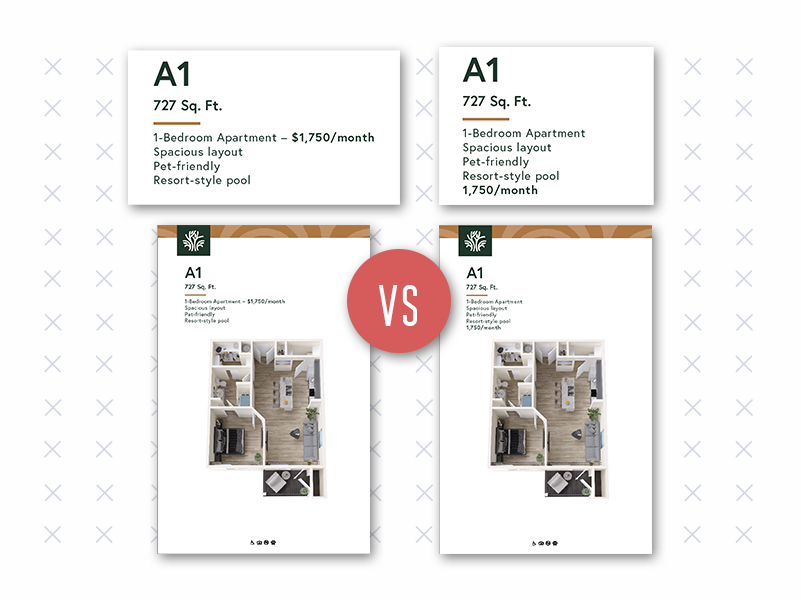
By placing the price at the end of the description, prospects process desire first, cost second.
2. Remove Currency Symbols Where Possible
If your website allows, show just numbers instead of “$1,750.” It seems small, but even slight reductions in psychological friction can improve conversion rates.
3. Use Larger, High-Impact Visuals
McDonald’s made their food images 40% larger to drive impulse purchases. Multifamily marketers can do the same by ensuring:
- Hero images on websites are lifestyle-focused (people enjoying the space, not just empty rooms).
- Floorplans are big, bold, and interactive, making units feel more tangible.
- Amenities are visualized with engaging imagery instead of just text descriptions.
4. Highlight “Most Popular” or “Renter Favorite” Floorplans
Just like McDonald’s highlighted best-sellers to drive decision-making, positioning select floorplans as popular choices can help renters feel more confident in their decision.
For example:
- “Most Leased Floorplan – Limited Availability”
- “Top Choice for Young Professionals”
- “Renter Favorite – Ask About Move-In Specials”
This nudges prospects toward higher-demand units while shifting focus from cost to value.
Why This Works for Multifamily
McDonald’s proved that pricing isn’t just about affordability — it’s about how people feel when they see the price. In multifamily, rent isn’t just a number; it’s an emotional decision.
When prospects first focus on the lifestyle, the amenities, and the experience, they’re more likely to justify the price as an investment in their ideal living space.
McDonald’s turned menu psychology into billions in extra revenue. Multifamily operators can apply the same principles to leasing — without lowering rent, adding incentives, or offering discounts.
A few small tweaks in how pricing is presented could significantly impact conversions, leasing velocity, and bottom-line revenue.
It’s not about lowering prices — it’s about elevating perception.

Generative AI in Marketing: Is Original Research Still Worth It?
AI-generated content has exploded in the last few years, making SEO efforts faster and more scalable than ever.
But with the rise of generative AI, are we losing true expertise? AI can churn out thousands of words in seconds, but is it just repackaging what’s already out there?
In contrast, original research brings something new to the table — data-driven insights that drive authority, build trust, and differentiate brands.
But scaling original research in SEO is tough. It takes time, effort, and resources.
So, in an era where generative AI is at our fingertips, is original research still worth the investment? Or are we headed toward a future where SEO is simply about who can produce content the fastest?
We asked eight thought leaders for their take on original research vs. AI-generated content, and the consensus is clear — while generative AI in marketing can enhance efficiency, original research remains the key to true authority.

The Challenge of Scaling SEO Through Original Research
Scaling SEO with original research is problematic because it requires time, money, and expertise. Unlike AI-generated content, which can be produced quickly, original research involves surveys, proprietary data collection, and industry reports.
Aaron Franklin, Head of Growth at Ylopo, knows firsthand how powerful original research can be. He ditched generic SEO tools for manual surveys and found that what people actually care about often differs from what search algorithms assume.
“In 2018, I manually surveyed 400 homeowners instead of relying on SEO tools,” Franklin said. “The result? A report revealing 68% cared more about commute times than school districts — a nuance algorithms missed. That study still drives 12% of our organic traffic today.”
Franklin’s experience highlights a key limitation of AI: It can summarize existing data, but it can’t generate new insights. This is why original research holds lasting value — it feeds unique, high-quality content into the SEO ecosystem rather than rehashing the same information AI scrapes from the web.
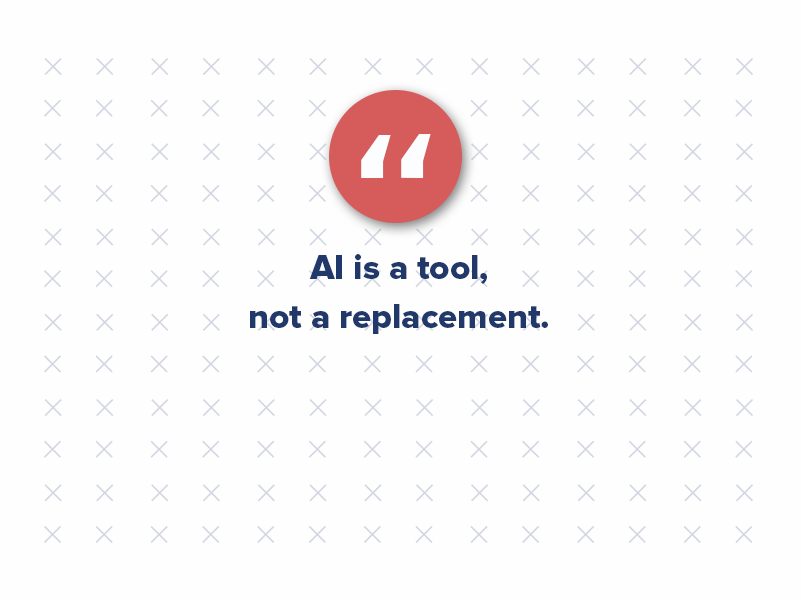
Why Original Research Still Matters in SEO
Many marketers agree: While original research is challenging to scale, it’s more impactful in the long run.
Lana Rafaela Cindric, SEO & Content Manager at SiteGuru, points out that people are tired of seeing the same recycled content online:
“Most content out there is rehashed and plain annoying to users who now turn to Reddit for fresh insights,” Cindric said. “We first look at what our data can tell us about audience challenges, then format it into what works best — blog posts, videos, or whitepapers. This has led to increased organic rankings and social shares.”
This is the real power of original research — it doesn’t just help SEO; it builds brand authority in SEO and thought leadership.
Darwin Liu, CEO of X Agency, emphasizes how original research sets brands apart:
“Scaling SEO with original research is challenging but rewarding. We’ve increased engagement by 50% through data-driven reports, secured high-authority backlinks, and created evergreen content that fuels long-term organic growth. AI can summarize, but it can’t replace real-world insights.”
Simply put, brands willing to invest in original research will own their niche, while those relying solely on AI-generated content risk blending into the noise.
AI + Original Research: Finding the Balance
The best approach isn’t choosing between AI and original research — it’s leveraging both. AI can process large datasets and summarize trends, but it works best when paired with original data that generative AI doesn’t have access to.
For example, Swayam Doshi, Founder of Suspire, ran a study on eco-friendly packaging preferences, and the results were game-changing:
“By publishing our findings, we saw a 41% increase in organic traffic within three months. AI made it easier to analyze the data, but the original research helped us stand out as a thought leader.”
Similarly, Laurence O’Toole, CEO of Authoritas, notes that original research plays a huge role in lead generation and competitive advantage:
“Original research works exceptionally well for high-quality lead generation and increased conversion rates. It also generates links and shares, positively impacting rankings.”
AI alone can’t create this level of engagement. But when AI is used as a supporting tool — to process data, automate tasks, or repurpose insights — it becomes a powerful asset in scaling research-driven content.
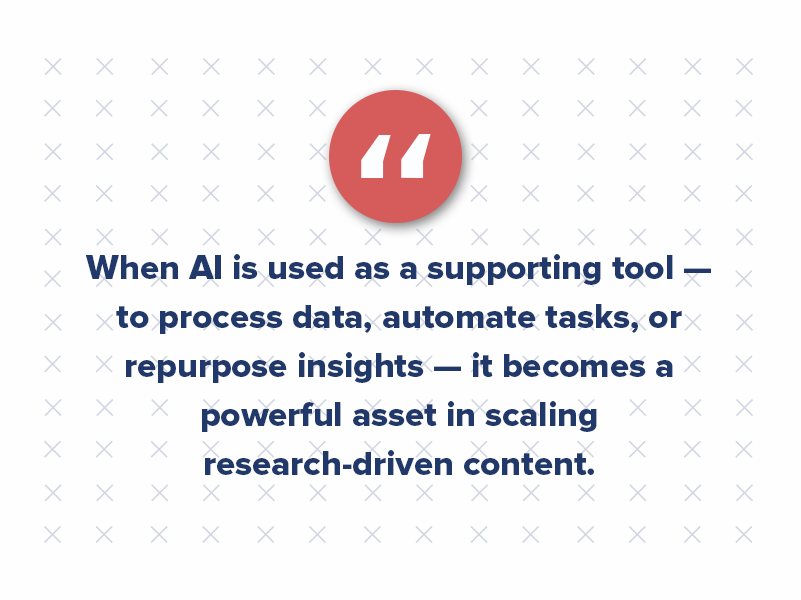
Are We Losing Expertise in the Age of AI?
With AI-generated content flooding the internet, some fear that true expertise is being lost. But for those willing to go beyond generic AI-driven content, the opportunity to stand out is greater than ever.
As Yoyao Hsueh, Founder and CEO of Floyi, puts it:
“Original research is the gold standard of content and SEO. AI can summarize existing knowledge, but it can’t generate new knowledge. That’s where real expertise comes in.”
At Criterion.B, AI is an incredibly useful tool for content marketing, but it should never replace human expertise. Brands that commit to producing new insights — whether through surveys, case studies, or proprietary research — will always have an edge.
The future of SEO isn’t about who can generate the most content the fastest. It’s about who can provide the most valuable content.
That’s what sets real thought leaders apart.

The Power of User-Generated Content in 2025
User-generated content (UGC) has been a cornerstone of digital marketing for years, but in 2025, its impact is more significant than ever.
With social media algorithms prioritizing authentic, community-driven content and consumers growing increasingly skeptical of traditional advertising, UGC is not just a nice-to-have — it’s a necessity.
UGC continues evolving from customer reviews and social media posts to video testimonials and influencer collaborations, shaping how brands connect with their audiences.

Why UGC is More Powerful Than Ever in 2025
Consumers trust real people more than they trust brands — plain and simple.
According to Tint’s 2024 State of UGC Report, 79% of people say UGC highly impacts their purchasing decisions, and 85% of consumers find UGC more influential than brand-created content.
This shift is largely due to the changing nature of social media and digital engagement. While polished, branded content still has its place, consumers now crave authenticity. Studies show that 90% of consumers say authenticity is important when deciding which brands to support. That means staged photoshoots and scripted testimonials don’t have the same impact they once did. Instead, audiences are drawn to real, unfiltered content from their peers.

The Algorithm Shift: Prioritizing UGC
Social media platforms are favoring UGC more than ever before. In 2024, Instagram, TikTok, and YouTube updated their algorithms to push more community-driven content to the forefront. This means:
- Brand-generated posts see less reach compared to organic, unpaid UGC.
- TikTok’s “For You” page prioritizes videos with high engagement, meaning a single customer review can go viral overnight.
- Instagram’s Collab feature and Threads integration encourage more organic conversations around brands, making real customer stories even more powerful.
- YouTube Shorts has become a hotspot for UGC-based tutorials and testimonials, with short-form video consumption at an all-time high.
This means brands that rely solely on professional content without leveraging UGC are missing out on massive organic reach.
How UGC Has Evolved in the Last Year
1. AI-Enhanced UGC
Artificial intelligence is now a part of the UGC landscape. Brands use AI to curate, analyze, and optimize UGC in real time. Tools like ChatGPT, Synthesia, and Runway allow marketers to personalize user content without losing authenticity. AI-assisted video editing helps create a more professional-looking UGC without diminishing its raw, organic appeal.
2. The Rise of Micro-Influencers & Nano-Influencers
Consumers trust everyday people more than celebrity endorsements. That’s why micro- and nano-influencers (accounts with 1,000–50,000 followers) now drive 60% more engagement than traditional influencers, according to Influencer Marketing Hub.
Brands are tapping into everyday customers, encouraging them to share experiences rather than relying on influencers with millions of followers. In fact, 80% of marketers say micro-influencer UGC is more effective at driving conversions than influencer partnerships with over 500K followers.
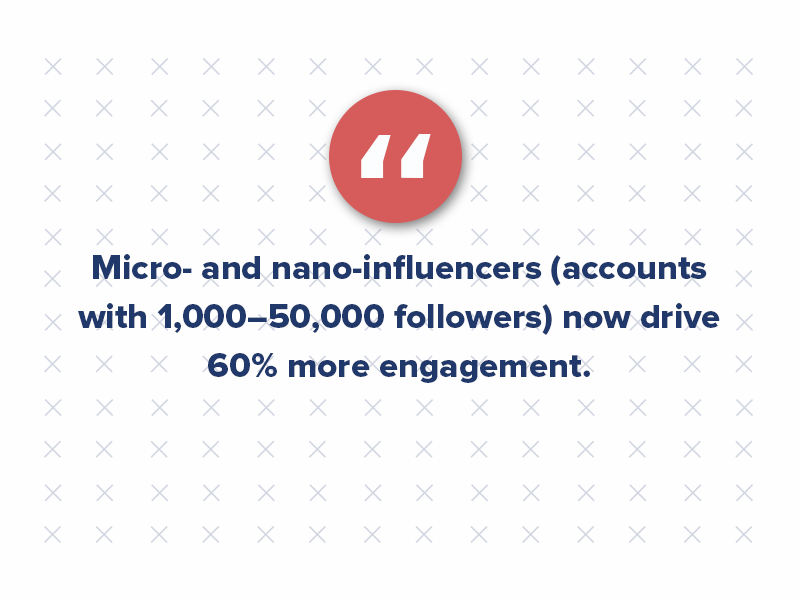
3. Long-Form UGC is Making a Comeback
Short-form content dominated the landscape in recent years, but long-form UGC is making a strong return in 2025. Consumers want deeper, more meaningful content from real users, leading to a rise in:
- YouTube vlogs and product deep dives
- Long-form customer reviews on LinkedIn
- Reddit and forum-based testimonials
- TikTok mini-docuseries featuring real customer experiences
These long-form pieces build stronger emotional connections with potential buyers, making them more likely to convert.
Examples of Successful UGC Campaigns in 2025
1. Airbnb’s “Host Stories” Series
Airbnb has capitalized on UGC by featuring real hosts sharing their experiences in short, engaging videos. The company highlights their struggles, successes, and what hosting means to them — turning everyday people into brand ambassadors. According to Airbnb, this strategy has led to a 30% increase in bookings from new hosts.
2. Starbucks’ “Red Cup Challenge”
Starbucks sees a flood of organic content every holiday season with its iconic red cups. Instead of creating their own marketing push, they launched the Red Cup Challenge, where customers were encouraged to post their most creative coffee moments. The result? Over 2.5 million Instagram posts featuring their holiday cups, making it one of their most successful UGC campaigns yet.

3. Nike’s “You Got This” Campaign
Nike’s newest campaign taps into real athletes and everyday people overcoming challenges. By encouraging users to share their fitness journeys using the hashtag #YouGotThis, Nike generated over 1 billion views on TikTok in just three months. This campaign resonated with consumers because it focused on real people, struggles, and triumphs rather than traditional ad campaigns.
How to Leverage UGC for Your Brand in 2025
1. Make UGC Part of Your SEO Strategy
Did you know that UGC can boost your search rankings? Google’s algorithm now prioritizes customer reviews, forum discussions, and social proof in its results. Encouraging UGC not only builds credibility but also enhances your online visibility.
2. Encourage Authenticity Over Perfection
Consumers can spot fake UGC from a mile away. Instead of overly polished testimonials, encourage raw, unfiltered content — even if it’s not 100% perfect. Brands like Glossier and Gymshark have built massive followings by leveraging real customer content.
3. Feature UGC Across Multiple Channels
Don’t just keep UGC on social media. Repurpose it in email campaigns, digital ads, and even product pages on your website. Some ways to incorporate UGC include:
- Adding Instagram photos to product pages
- Featuring real customer testimonials in email marketing
- Using customer-submitted videos in paid social ads
4. Launch a UGC Incentive Program
Want more UGC? Give your audience a reason to participate. Offer discounts, exclusive access, or giveaways in exchange for high-quality content. Programs like Lululemon’s Ambassador Program and Sephora’s Beauty Insider Community thrive because they reward customers for their content contributions.
The Future of UGC in 2025 & Beyond
User-generated content isn’t just a marketing trend — it’s the backbone of modern brand trust and engagement. As AI-driven content creation grows, UGC will remain one of the last true sources of authenticity in marketing.
Brands that harness the power of UGC will see higher engagement, better conversions, and a stronger connection with their audience. Those that don’t? They risk falling behind in an era where consumers crave real over manufactured.
If you’re not already prioritizing UGC, now’s the time. Because in 2025, the brands that succeed won’t be the loudest — they’ll be the most authentic.

Mastering AEO: The Key to Engaging Renters in an Evolving Search Landscape
As search evolves from delivering blue links to providing direct answers, Answer Engine Optimization (AEO) has emerged as a pivotal strategy in digital marketing.
AEO focuses on optimizing content, so it’s primed for platforms like Google’s Search Generative Experience (SGE), voice assistants, and AI-driven tools like ChatGPT. For multifamily marketers, embracing AEO is not just optional — it’s essential to stay ahead in a competitive market.

What Is AEO, and Why Does It Matter?
AEO is the process of optimizing content to ensure it appears as a direct answer to users’ queries. Unlike traditional Search Engine Optimization (SEO), which targets general keyword rankings, AEO focuses on delivering concise, accurate, and structured responses that align with user intent.
AEO boosts organic traffic by securing spots in answer boxes and featured snippets, which dominate search engine visibility. With 58% of consumers turning to voice search for local businesses, optimizing for this format enhances local SEO and drives valuable traffic to your site.
In 2025, users will increasingly rely on AI tools and voice search for quick answers. For example:
- Renters might ask their devices, “What are the best pet-friendly apartments near me?”
- Potential clients might search, “Which amenities are most popular in luxury apartments?”
To capture these moments, multifamily brands need to position their content as the best, most relevant answer.
Our Stance on AEO
At Criterion.B, we view Answer Engine Optimization (AEO) as an evolution of traditional SEO, not a replacement. While organic rankings remain crucial, AEO focuses on delivering immediate, actionable answers that align closely with search intent. This shift is about meeting users where they are, especially on search engine results pages (SERPs), increasingly dominated by featured snippets and AI-powered summaries.
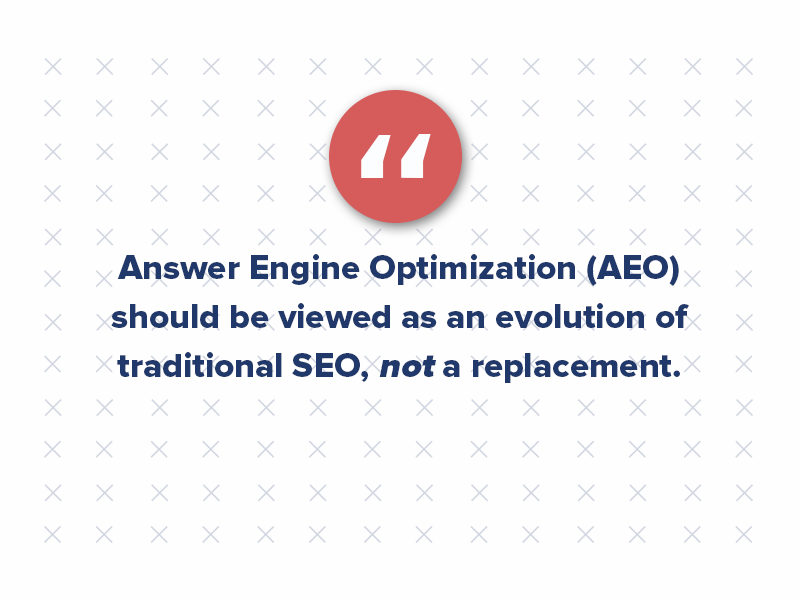
For multifamily websites, embracing AEO means balancing traditional SEO strategies with content designed to address user questions directly. This approach allows for better visibility in both organic search results and answer boxes, driving organic traffic while enhancing the overall user experience.
To thrive in an AEO-driven landscape, we recommend multifamily brands adopt a strategy that emphasizes:
Concise and Clear Content
Content should be structured to optimize for featured snippets, ensuring it answers specific queries clearly and succinctly. For example, FAQs, bullet points, and headers can help search engines identify your content as relevant to user searches.
Data-Driven Insights
Leverage keyword research to understand what your audience is asking and what resonates with them. Search intent is key — know whether your audience is looking for quick answers, detailed guides, or actionable advice. For instance, Ahrefs reports that nearly 8.6% of clicks go to featured snippets, highlighting the value of appearing in these high-visibility spaces.
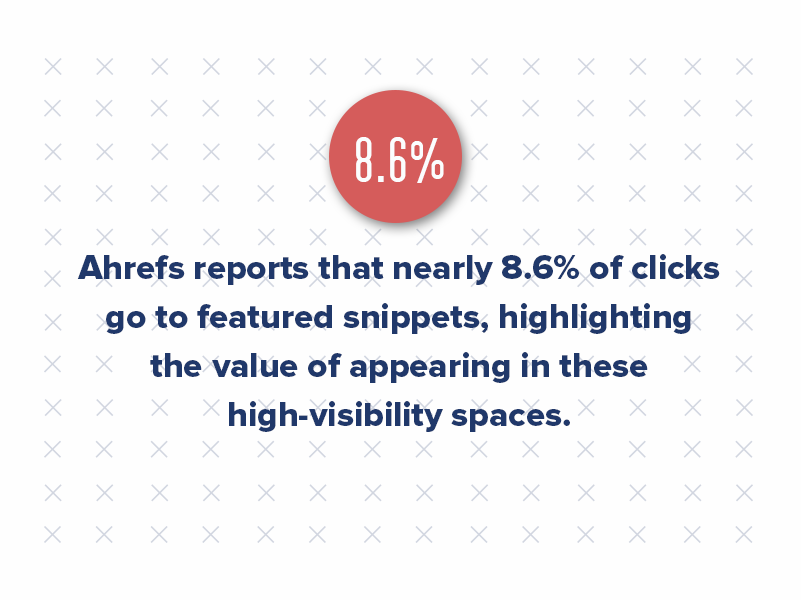
Engaging and Relevant Formats
Content from video snippets to visually appealing infographics should be tailored to engage users. Tools like Semrush have shown that rich content formats can boost click-through rates significantly, especially when paired with structured data for better discoverability.
Integration with Broader SEO Strategies
Answer engine optimization isn’t about abandoning traditional SEO but enhancing it. Multifamily marketers should aim for a balanced approach that aligns AEO efforts with ongoing SEO strategies, such as improving organic search rankings, creating relevant blog posts, and focusing on user experience.
In 2025, the rise of generative AI and voice search will further amplify the importance of optimizing content for answer boxes and search results pages. At Criterion.B, we see AEO as a vital tool in a broader marketing toolkit — one that complements branding, local SEO, and engagement tactics to deliver tangible results.
How AEO Is Changing Multifamily Websites
Featured snippets and answer boxes capture a notable share of clicks, with studies showing they account for an average of 8.6% of top-position clicks. This underscores the importance of optimizing content to answer user queries directly, especially as featured snippets are commonly used in voice search results.
AEO is transforming how multifamily websites are designed and optimized. Key changes include:
Enhanced FAQ Sections
Websites now need robust FAQ pages that anticipate user queries. For example, questions like “What amenities are included?” or “How far is this community from downtown?” should be addressed with clear, concise answers optimized for text and voice search.
Schema Markup Integration
Structured data is critical for answer engine optimization. Multifamily websites must implement schema markup to help search engines understand content context, such as floorplans, pricing, and availability.
Focus on Local Search
Local SEO has become even more important in the AEO era. Queries like “affordable apartments near [city]” are answered more effectively when Google can identify accurate NAP (Name, Address, Phone) information and localized content.
Voice Search Optimization
With more renters using voice search, websites must adapt to conversational queries. Content must mimic natural language and focus on long-tail keywords to cater to these search patterns.
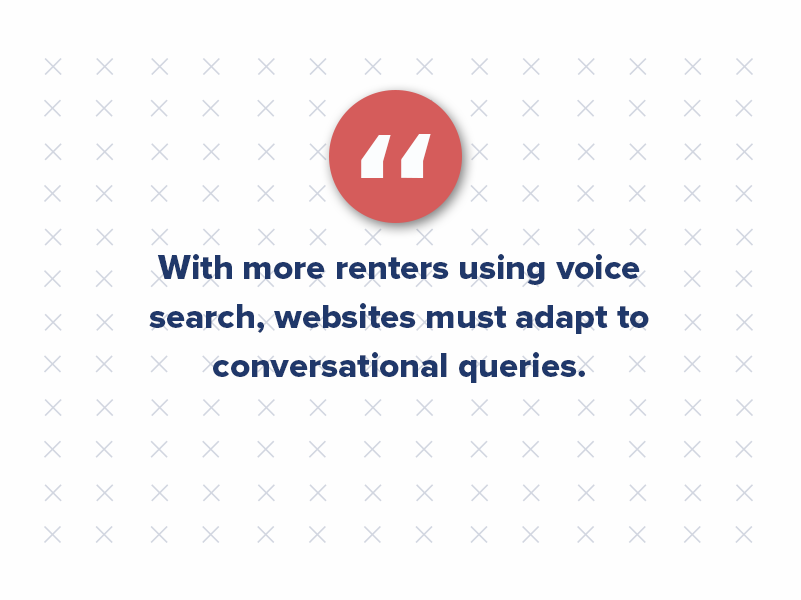
The Status of AEO in 2025
As of 2025, answer engine optimization has become a mainstream practice. Major search engines, voice assistants, and AI platforms rely on algorithms to prioritize direct, relevant answers. Multifamily marketers are seeing:
- Higher Engagement Rates: Answer-focused content captures attention more effectively.
- Improved Conversion Rates: Renters who find precise information are more likely to act quickly.
- Increased Dependence on Structured Data: Without structured data, even high-quality content risks being overlooked by AI-driven systems.
However, challenges remain. Many brands struggle to balance providing direct answers with driving traffic to their websites. The shift from clicks to zero-click results requires a new approach to measuring success.
How AEO Will Affect Multifamily Marketing
Content Prioritization
Content strategies will prioritize answering high-intent questions and making blogs, FAQs, and community pages essential for attracting and engaging renters.
Increased Importance of Video
Video snippets are becoming a preferred format for AI systems. Multifamily marketers must invest in high-quality videos showcasing property tours, amenities, and resident testimonials.
Shift in Metrics
Traditional SEO metrics like clickthrough rates (CTR) may decline as AI provides answers directly. Marketers must focus on engagement metrics, such as time on page and lead form completions, to gauge effectiveness.
Greater Role of AI Tools
Generative AI tools like ChatGPT are already being used to craft AEO-friendly content. Multifamily marketers can leverage these platforms to produce natural, engaging answers tailored to renter queries.

How Are People Adapting?
As SGE and answer engine optimization take center stage in searches, businesses are rethinking their strategies to stay competitive in an AI-driven world. From retraining marketing teams to redesigning websites for better usability, the focus has moved to creating content that serves both human users and search engines. Here are a few ways our agency and our clients are adapting:
Investing in AEO-Focused Training
Multifamily marketing teams are being trained to think beyond traditional SEO. Understanding how search engines interpret queries and structure results is now a critical skill.
Refreshing Website Content
Websites are being reimagined to prioritize user intent. Navigation is simplified, and content is structured for human readability and machine parsing.
Collaborating With AI Experts
Brands are partnering with AI specialists to optimize their content for tools like SGE and voice assistants. This collaboration helps maintain visibility in a rapidly evolving landscape.
Building Trust Through Transparency
As AI-generated content increases, transparency matters more than ever. Including disclaimers about AI involvement in content creation fosters trust and aligns with consumer expectations.
We’re in Our AEO Era
Answer engine optimization represents the future of search, offering multifamily marketers a unique opportunity to connect with renters more meaningfully. Focusing on user intent, leveraging structured data, and adapting to new search behaviors will become key so multifamily brands can remain competitive in a crowded digital landscape.

The Effectiveness of Predictive Advertising in Multifamily
Predictive advertising has been touted as “the next big thing” in digital marketing — promising marketers smarter targeting, better-qualified leads, and cost-effective ad spend.
Other companies have championed the technology, claiming that predictive analytics can help forecast future renter behavior based on past data, making ad targeting more precise and impactful. But is predictive advertising really the game-changer it claims to be? Does it deliver “said results?”
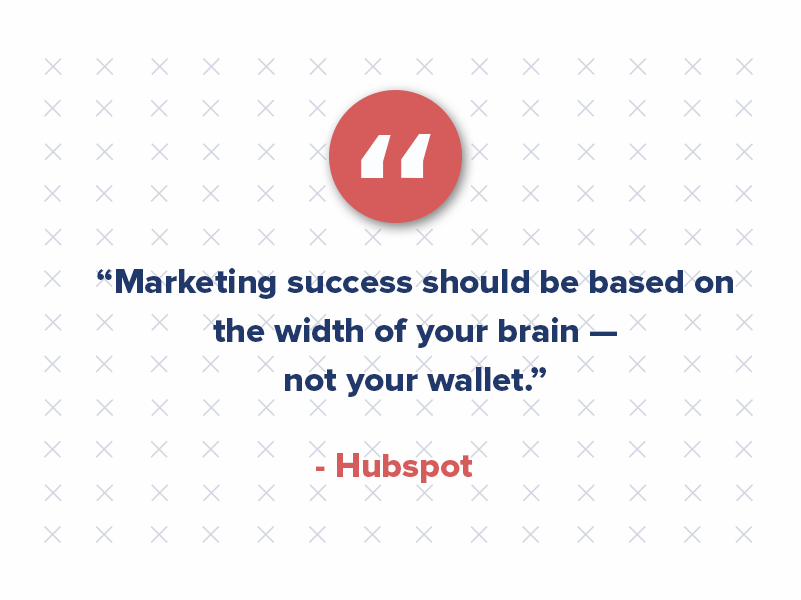
After digging into recent research and analyzing industry results from the last year, the evidence suggests that the effectiveness of predictive ads, especially in multifamily marketing, may not be as clear-cut as proponents would like us to believe.
In fact, we’ve found that more transparent strategies can often deliver better results, which is why we’ve steered away from predictive ad services.
Let’s explore why predictive ads fall short and why Criterion.B takes a more straightforward approach to multifamily marketing.

What Is Predictive Advertising?
If you have spent time working on digital ads, you know the cost has risen significantly in recent years. Meta’s cost per thousand (CPM) has increased 61% yearly, and Google’s programmatic display CPMs increased 75% in the same period, according to The Drum. Meanwhile, many brands are tightening their budgets due to economic uncertainty, yet consumers are expecting better ad targeting, personalization, and overall messaging than ever before.
So how have advertisers and agencies attempted to combat this? Well, they’ve been dabbling in predictive ads (or trying).
“We rushed into [predictive advertising], hoping for big returns but ended up spending too much with little to show for it,” said James Heartquist, owner at Modern Property Solutions. “Our main problem was not using our budget wisely, which led to few sales.”
Predictive analytics uses artificial intelligence (AI) and data from past campaigns to forecast future behaviors. In theory, it allows marketers to target potential renters before they know they’re in the market for an apartment. The idea is simple: by using data like browsing habits, previous searches, demographics, subscriptions, and demographic information, you can predict who is most likely to convert and target your ads accordingly.
Predictive advertising is a subset of predictive analytics that uses historical data, machine learning techniques, and algorithms to target audiences and optimize ad copy and media spending accurately.
In essence, predictive advertising enables brands to build highly targeted audience segments based on millions of behavioral signals and customer attributes. There are several key techniques used in predictive advertising, each offering different levels of sophistication and impact:
- Look-alike modeling: This technique identifies new users who resemble an existing customer group. It’s a simple approach often built into platforms like Facebook and LinkedIn.
- Classification modeling: Similar to look-alike modeling but with an additional layer of filtering, this method excludes users who aren’t ideal targets.
- Click-based optimization: By analyzing user intent, AI predicts the likelihood that a customer will take specific actions, such as clicking on an ad or making a purchase.
- Uplift modeling: This advanced technique predicts how an ad or intervention will affect a customer’s likelihood of purchasing, giving brands even deeper insight into campaign effectiveness.
The Predictive Ads Promise vs. Reality
Companies promote predictive advertising as a way to get more qualified multifamily leads at a lower cost. According to them, this technology helps to refine Google Ads targeting and reach potential renters earlier in their decision-making process.
While this sounds great in theory, industry research shows the results aren’t always as successful as predicted. The goal is to create a more personalized and timely ad experience, but predictive ads can struggle with accuracy as they rely on assumptions about behavior that can be hard to validate. As multifamily experts highlight, the unpredictable nature of renter decision-making makes it difficult for these systems to consistently deliver better conversion rates.
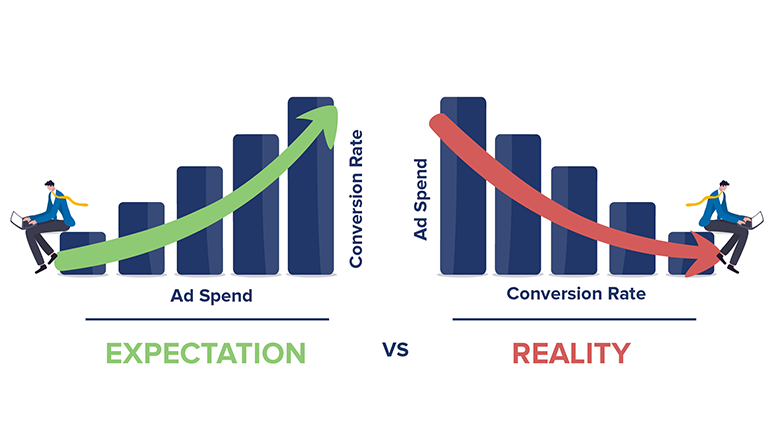
Recent Conversion Logix data showed that while predictive ads could improve click-through rates, the conversion rates (lead-to-lease) weren’t significantly better compared to more straightforward advertising methods.
Predictive Ads Struggle With Accuracy
One of the significant flaws with predictive ads is their reliance on historical data to forecast future behavior. Companies without access to substantial, high-quality data sets may find it challenging to create accurate predictive models.
“A primary challenge for multifamily and real estate marketers in predictive advertising is navigating its complex processes,” said Zach Shepard, principal at Braddock Investment Group Inc. “It involves collecting large amounts of data from multiple sources, analyzing it accurately, and using it to make predictions about potential customers or tenants. This can be a daunting task for those who are not familiar with data analysis and predictive modeling.”
Shepard believes many marketers may lack the necessary tools or resources to implement a successful campaign, which could result in inaccurate predictions or an ineffective strategy that does not yield the desired results.
“In some cases, the negative experience with predictive advertising may stem from unrealistic expectations,” said Shepard. “Marketers may expect immediate and drastic improvements in their marketing efforts without considering the time and effort required to collect and analyze data for accurate predictions.”
Even when sufficient data is available, predictive algorithms often overlook critical variables such as weather changes, shifting moods, or personal relationships — factors that can dramatically influence purchasing decisions in ways that a computer cannot easily anticipate.
“One of the primary issues that marketers face with predictive advertising is inaccurate targeting,” said Robert Fausette, owner of Revival Homebuyer. “Predictive algorithms use data analysis to predict which individuals are most likely to take a certain action, such as clicking on an ad or making a purchase. However, this data is not always accurate and can lead to targeting the wrong audience. This results in wasted advertising budget and lower conversion rates.”
Multifamily Executive reported that renter behavior can be highly volatile, especially in uncertain economic times, making predictive analytics less effective. Renters’ priorities shift based on changing market conditions, economic factors, and personal circumstances that predictive algorithms struggle to account for.
Additionally, predictive models are not static and must be updated continuously to remain relevant. As customer behavior evolves, a model that once worked may quickly become obsolete, leading to inaccurate predictions and wasted ad spend. A perfect example is the 2008 financial crisis, where models predicted mortgage customers would repay loans but failed to account for the collapse in U.S. housing prices.
“Our biggest challenge was getting good leads that actually turn into customers,” said Dino DiNenna, real estate broker at Hilton Head Realty Sales. “We tried a big ad campaign for our fancy apartments, and while lots of people clicked, not many ended up applying. It was frustrating to see all those clicks but so few real leads.”
In multifamily marketing, relying too heavily on outdated models can result in poor targeting, ineffective ad spend, and ultimately, lower ROI. While predictive advertising offers potential, its limitations make it less reliable compared to real-time data-driven approaches that adapt to renters’ immediate needs and behaviors.
In contrast, real-time data like live pricing updates and real-time availability are far more accurate because they reflect the current state of the market. BestEverCRE found that renters are more likely to convert when presented with up-to-date, transparent information such as pricing, unit availability, and immediate offers. This real-time approach provides actionable data, allowing for a more direct path to conversion without relying on speculative forecasts.

The Case for Simplicity: Live Pricing and Availability
One of the most compelling arguments against predictive ads is the simplicity and effectiveness of using real-time data. MultifamilyBiz highlighted that real-time availability and pricing updates directly impact conversion rates because they offer renters the information they need when needed.
By focusing on strategies that prioritize transparency — like showing what units are available right now or offering dynamic pricing — you create a more immediate sense of urgency and trust. Renters are far more likely to act when they know exactly what’s available, at what price, and when they can move in.
Ashley Gawley LRE, founder at Launch Real Estate, advises balancing data with understanding the hyperlocal market, property, and target audience. “For multifamily, look at lease-up rates, turnover, and demand for specific unit types — not just broad demographics,” Gawley said. “Consider hosting focus groups to gain qualitative insights into what’s really driving people’s housing decisions.”
Michael Yerardi, owner of Turning Point Home Buyers also faced challenges with predictive ads when the qds were not matching up with how residents felt about living at the properties. “We listened to what our residents had to say and made big changes,” Yerardi said. “For example, we promised to fix things within 24 hours, which made people much happier. By focusing on making life better for our residents — not just on flashy ads — we got 20% more people to stay with us.”
At Criterion.B, we’ve seen firsthand that simpler methods can outperform more complex, algorithm-based systems like predictive ads. Instead of trying to guess what renters might want in the future, we focus on delivering relevant, real-time information that speaks directly to their current needs.
The Fallacy of Predictability
Predictive advertising often promises that with enough data, marketers can forecast consumer behavior with precision. However, this is where the fallacy of predictability comes into play.
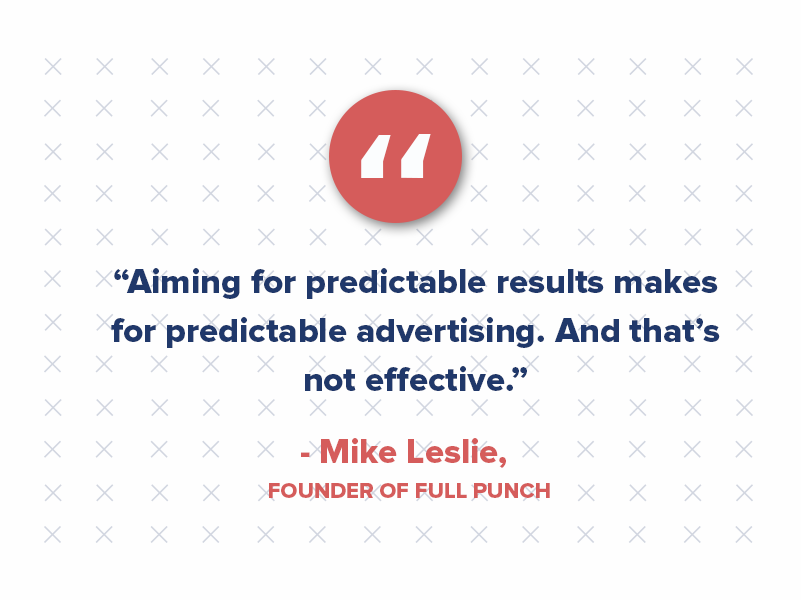
The desire for predictability can lead brands to rely on data and past performance to the point of stifling creativity and innovation. While predictive tools analyze everything from location to preferences, purchases, and search history, they ultimately fail to account for the messiness of human behavior. They can’t account for the emotional and personal factors influencing renter behavior.
Advertising has never been an exact science, nor should it aim to be. The idea that past consumer actions can reliably predict future behavior is flawed, and companies relying too heavily on predictive analytics will likely experience diminishing returns. Past performance does not predict future results. The repetition of predictable tactics inevitably leads to stagnation.
While data can provide insights, the art of advertising lies in its ability to engage, surprise, and break through the ordinary. It’s not about being predictable but about showing up in unexpected places and finding the human connection that resonates with people on a deeper level. Effective advertising is about understanding human behavior — not just the data sets it generates — and creating campaigns that reflect society’s complex, ever-changing nature.
Brands that rely solely on predictive ads risk becoming part of the ignorable 85% of ads that go unnoticed. By rejecting the predictable and embracing creativity, companies can produce advertising that stands out, breaks norms, and becomes part of the cultural conversation.
“We invested in a campaign aimed at prospective renters based on data analytics, but the audience we reached often didn’t align with our ideal tenant profile,” said Justin Landis, founder of The Justin Landis Group. “Many of the leads we received were unqualified, leading to a low conversion rate and wasted marketing dollars. We also faced challenges with the technology itself. The predictive models sometimes failed to account for local market nuances, resulting in ads that felt generic and disconnected from our community’s needs. This misalignment made the campaign feel less personal, and potential renters often overlooked our offerings.”
“The negative experience was frustrating, as we had high hopes for improving our lead generation,” Landis continued. “To pivot, we shifted our focus from purely data-driven advertising to a more integrated approach that included community engagement and personalized messaging. We began leveraging social media to connect with potential renters directly and gather feedback.” This approach enhanced the brand image of The Justin Landis Group. It allowed the company to tailor its offerings to meet audience needs better, ultimately leading to more successful marketing outcomes.
In the multifamily space, where renters’ needs and expectations evolve quickly, it’s essential to stay agile. Predictive ads, with their focus on past data, can leave marketers blind to new opportunities or shifts in renter behavior. Instead of leaning on predictive analytics, focusing on live data, real-time updates, and human-driven insights will allow brands to remain relevant and adaptable in a constantly changing market.
“We learned the hard way that keeping up with what residents want is crucial,” said Nick Stoddard, CEO at KC Property Connection. “We once ran ads aimed at young professionals, but it flopped because we didn’t consider families looking for bigger homes. After tweaking our approach to include families, we saw a big jump in leads and a 15% increase in occupancy rates. This experience taught us that regularly updating our marketing strategies is key to staying on top of changing resident needs.”
The Human Element: Why Predictive Ads Miss the Mark
While artificial intelligence (AI) is growing in digital marketing, its use in long-form content and predictive advertising isn’t without challenges. AI tools used in predictive analytics often simplify complex behaviors into data points, missing out on the nuances of human decision-making.
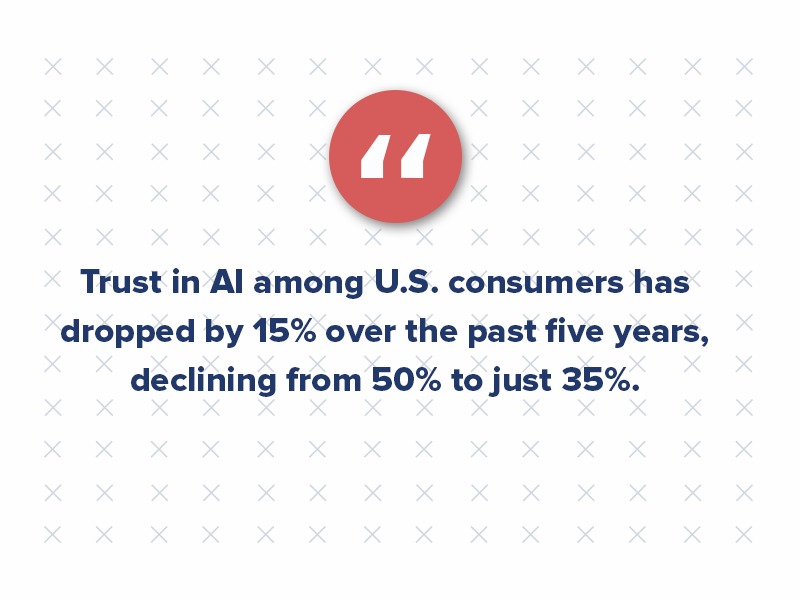
AI-driven predictive ads are not always effective in capturing the attention of renters seeking personalized experiences. Renters prefer authentic and relevant brands, which AI-driven, predictive models often struggle to achieve. Psychology Today reported that 70% of consumers spend more with authentic brands.
“The overreliance on AI in predictive advertising presents a challenge for us,” said Ryan Whitcher, founder and CEO of Harmony Home Buyers. “We initially embraced AI for our ad campaigns but soon realized it led to biased targeting and a 30% drop in qualified leads over three months. To address this, we implemented a hybrid approach, combining AI with human oversight, resulting in a 25% increase in qualified leads within two months and teaching us the importance of balancing technology with human expertise in our marketing strategies.”
Although 77% of advertisers have a favorable opinion of AI, consumer sentiment tells a different story. A 2024 report from the Edelman Trust Institute revealed that trust in AI among U.S. consumers has dropped by 15% over the past five years, declining from 50% to just 35%.
Also, a recent Neil Patel study found that content marketing incorporating personalization and emotional engagement outperforms data-driven, predictive ad strategies by 94.12%. Renters want to feel connected to the brand they’re considering, and predictive ads often fail to create that connection.
At Criterion.B, we prioritize building trust and emotional engagement through tailored content, real-time updates, and personal interactions. This approach builds lasting relationships, which is something predictive ads can’t do.
Why We Don’t Offer Predictive Ads
At Criterion.B, we’ve done our research. While predictive advertising may have its place in certain industries, the multifamily market demands a more dynamic, real-time approach. The unpredictable nature of renter behavior — combined with the increasing need for transparency and trust — means that predictive ads often fall short.
Rather than relying on speculative technology, we focus on proven methods: real-time pricing, availability updates, tailored content, and building genuine connections with renters. This approach doesn’t just drive traffic — it builds relationships. So while the allure of predictive ads is tempting, we’re committed to more personable (and reliable) strategies.

Here’s What You Need to Know About Content Length in 2024
With the rise of social media, short attention spans, and AI-generated content, many marketers question long-form content’s relevance. Is it still effective in today’s fast-paced digital landscape, or is it being overshadowed by bite-sized, easily digestible posts and videos?
The answer isn’t as simple as “long vs. short” — both have their place.
But long-form content is far from dead when it comes to SEO, audience engagement, and building authority. In fact, it’s more powerful than ever.
What Is Long-Form Content?
Before diving in, let’s clarify what long-form content is. Long-form content generally refers to blog posts, articles, videos, or other media that exceed 1,200 words or last more than 10 minutes. These pieces provide in-depth information, answering more complex questions and offering detailed insights. This type of content can include everything from blogs and eBooks to long-form video content on platforms like YouTube.
The Power of Long-Form Content for SEO
We often hear: “Nobody reads long-form content anymore.” Attention spans are shrinking — 20 years ago, people focused for about 2.5 minutes, and today, it’s down to just 45 seconds. In many industries, the average word count for content is dropping.
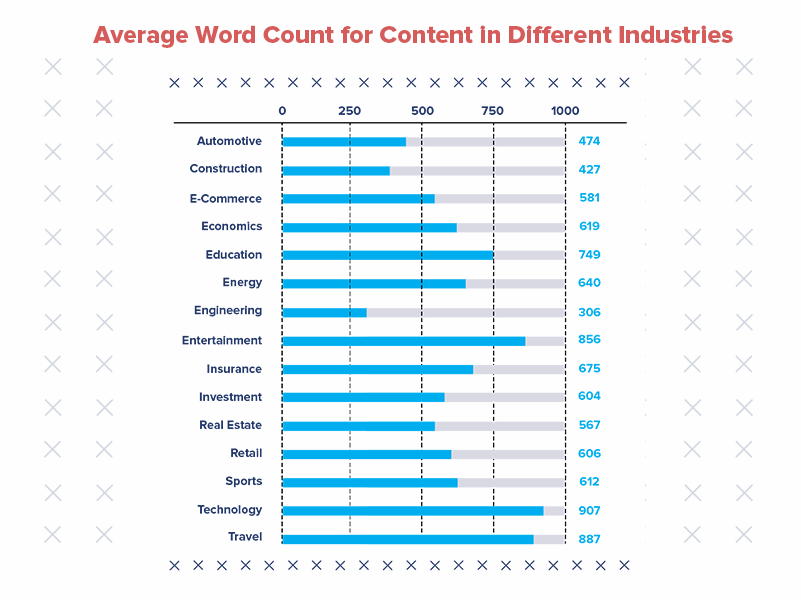
But here’s the thing: people will absolutely focus on long-form content if it’s about a topic they’re passionate about.
The rise of video essays on YouTube — many of which last over an hour — and TikTok testing 15-minute video uploads prove that audiences still crave depth and detail, as long as it’s compelling.
This engagement doesn’t happen by accident. Keeping people’s attention on long-form content takes skill. It requires understanding when to take a deep dive and when brevity is better. And this is where long-form content excels for SEO — it not only captures attention but holds it, offering value that resonates with readers.
Google’s John Mueller has pointed out that search engines favor content that thoroughly addresses user intent, and that’s where long-form content shines.
According to HubSpot, blog posts between 2,100 and 2,400 words perform best in organic search results. This length allows for in-depth keyword optimization and thorough topic exploration and provides ample opportunities for internal linking and backlinks.
Neil Patel’s research backs this up. His studies show that articles exceeding 2,000 words generate more backlinks and social shares than shorter pieces, proving that quality, detailed content remains critical for SEO success. Long-form content is especially powerful in building domain authority and helping websites rank higher on search engine results pages (SERPs), which leads to more traffic and conversions.
And according to Ahrefs data, most (91%) of all online content gets no organic traffic from Google. This isn’t necessarily because of poor heading structures or keyword stuffing; it’s often because the content doesn’t offer the depth or quality needed to attract meaningful engagement. Long-form content helps you overcome this by providing value.
Even as attention spans decline, long-form content remains an indispensable tool for SEO, driving sustained engagement, building trust, and ensuring that your content doesn’t just get read but ranks, too.
Does AI for Long-Form Content Work?
In today’s landscape, the use of AI for long-form content is becoming more common. AI tools like Gemini, Jasper, and ChatGPT can help generate ideas, structure articles, and even write large portions of long-form content. But while AI can assist with the creation process, it’s still essential to layer in human expertise, creativity, and insights to produce high-quality content.
AI is great for scaling content production, but it may struggle to deliver nuanced, audience-specific details that make content engaging. In short, AI can help create long-form content, but it shouldn’t fully replace human input, especially when your goal is to connect with readers and offer unique perspectives.
Long-Form vs. Short-Form Content: Which Performs Better?
It’s not a battle of long-form vs. short-form content; rather, both types of content have their place in a balanced marketing strategy.
The Case for Short-Form Content
While long-form content has undeniable benefits, short-form content still plays a crucial role in marketing strategies, particularly when capturing quick attention and providing easily digestible information. In a world of fleeting attention spans, short-form content — whether it’s videos, social media posts, or concise blog entries under 1,000 words — can quickly engage users and drive immediate action.
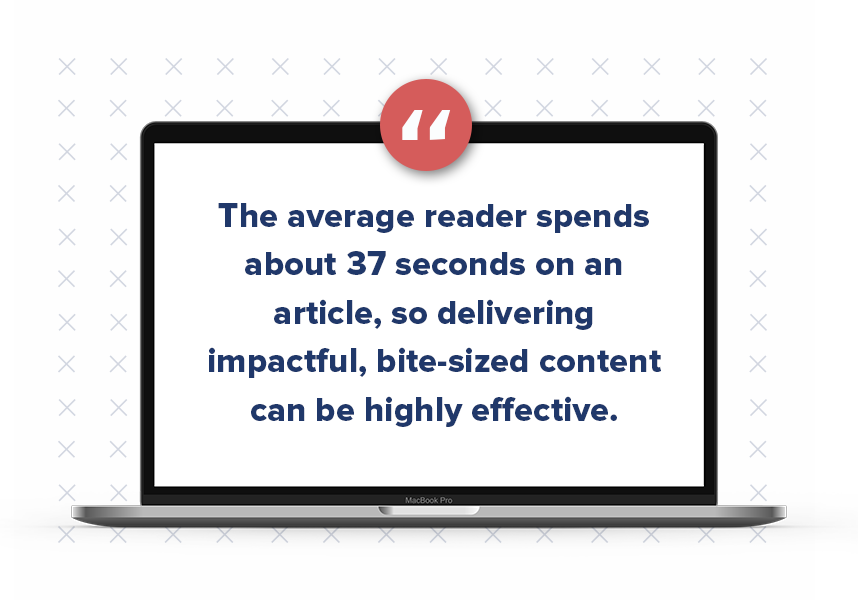
When it comes to written content, short-form blogging offers an opportunity to stay top-of-mind with your audience without overwhelming them. According to HubSpot, the average reader spends about 37 seconds on an article, so delivering impactful, bite-sized content can be highly effective, especially when users are looking for quick answers or need a fast overview. Blogs of 500-700 words, for instance, are perfect for addressing specific questions, ranking for targeted keywords, and keeping readers engaged without requiring a significant time investment. Listicles are a great way to pack in a lot of high-value content and specific keywords while making your content easily scannable, digestible, and succinct.
Short-form written content also works well for brand storytelling and building relationships with customers. Regular blog posts that are brief but packed with value can foster loyalty and ensure your audience keeps coming back for more. As the demand for faster information grows, more companies are using short-form blogs to drive email sign-ups, retargeting ads, and social shares.
The same principle applies to short-form video content, which has seen an explosion in popularity thanks to platforms like TikTok, Instagram Reels, and YouTube Shorts. These formats are perfect for audiences looking for quick entertainment or fast solutions to problems.
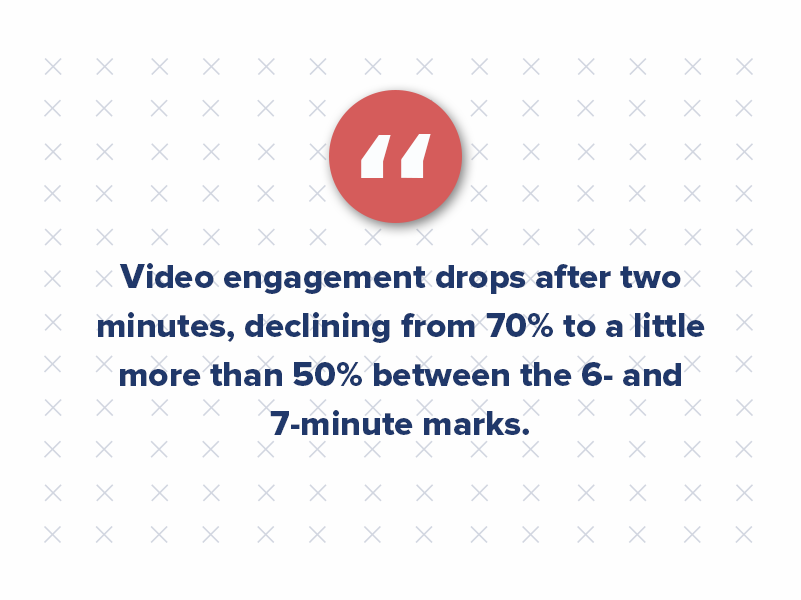
Vidico reports that video engagement drops after two minutes, declining from 70% to a little more than 50% between the 6- and 7-minute marks. Various reports state that videos 2 minutes long get the most engagement, making them perfect for platforms where users scroll quickly and want immediate gratification.
Social media audiences, especially younger demographics like Gen Z, are drawn to quick, snackable content that delivers instant value. Shorter videos are easier to consume, share, and engage with; they also align with shorter attention spans. Research also suggests shorter videos align with shorter attention spans and are more likely to sustain viewer attention.
The Case for Long-Form Content
Despite the rise of short-form media, long-form content is more effective for in-depth topics and SEO. When you answer complex questions or provide comprehensive guides, your content is more likely to attract links, shares, and higher engagement over time.
The ideal blog length has always been a moving target. At one point, the wave of 750-word posts dominated the landscape, but as content marketing matured and competition grew, blog posts expanded to over 2,500 words to offer more comprehensive, valuable insights. This trend was further fueled by strategies like the SEO skyscraper technique, where longer content aimed to outperform competitors and earn backlinks. It wasn’t uncommon for articles to exceed 3,000 words, and many thought leaders (Criterion.B included) advocated for more in-depth content to meet rising expectations.
In fact, research supported the push for longer content. HubSpot found that the ideal blog length fell between 2,100 and 2,400 words. Similarly, Semrush revealed that articles over 3,000 words generated 138% more search traffic.

However, with the surge of AI-generated content and the influence of the “TikTok Effect,” audiences now crave content that gets to the point faster. Today’s ideal length tends to hover between 1,500 and 2,000 words, striking a balance between depth and brevity. Neil Patel agrees, stating that the ideal content size is smaller now and quicker to reach the point. The key takeaway is that while word count still matters, quality and value are now the real metrics of success.
The performance of long-form video content also varies depending on the topic shared. On platforms like YouTube, longer videos (10 minutes or more) tend to rank higher in search results and generate more ad revenue. YouTube’s algorithm favors long-form video content because it keeps users on the platform longer, increasing engagement metrics. Some of the best long-form content on YouTube includes educational videos, detailed product reviews, and deep-dive tutorials.
For long-form video content, quality still matters. It’s not just about the length — it’s about how effectively the video engages, educates, or entertains your audience. A well-produced, long-form video can dramatically boost your channel’s visibility and lead to higher engagement, especially if paired with the right SEO strategies.
How Long Should Your Content Be?
So, what is considered long-form content, and how long should your content really be? The answer depends on your goals:
- For SEO: Articles between 2,100 and 2,400 words perform the best, according to HubSpot.
- For Engagement: Longer blog posts (around 3,000 words) and long-form video content (10+ minutes) are ideal for creating in-depth, shareable pieces that drive traffic.
- For Social Media: Short-form content (under 2 minutes for videos, under 1,000 words for posts) tends to get the most engagement, particularly on platforms like Instagram and Twitter.
- For Lead Generation: Both long and short content can be effective, but long-form content excels in building trust and nurturing leads over time.
The Verdict: Long-Form Content Is Here to Stay
Is long-form content dead? Absolutely not.
In fact, it plays a critical role in building brand authority, improving SEO, and driving qualified leads. However, it’s essential to integrate short-form content as well, especially for social media engagement and brand visibility.
The key is balance. Create a mix of long-form vs. short-form content that caters to different platforms and audience preferences. Use long-form content to dive deep into topics, improve SEO, and establish authority, while short-form content can be used for brand awareness and quick engagement.
Whether it’s a 3,000-word article, a detailed case study, or a short, snappy video, content that delivers real value will always have a place in your marketing toolbox. So, while shorter attention spans might drive the demand for short-form content, long-form content isn’t going anywhere — and it’s still a crucial part of a well-rounded marketing strategy.
Proven Marketing Strategies From Industry Leaders You Can Start Using Today
Marketing can sometimes feel like a game of trial and error, but a few tactics consistently hit the mark.
We’ve chatted with 16 industry pros who’ve nailed down the strategies that work, from the power of cause marketing to the smart use of content repurposing.
Here’s a look at the marketing tactics these experts can’t live without — and why they’re so effective.

1. Champion Cause Marketing
One marketing strategy example that has shown immense success is cause marketing. Patrick Beltran, Marketing Director at Ardoz Digital, explains that this approach involves partnering with nonprofit organizations and charities to support meaningful causes. By aligning your multifamily brand with a cause, you add a human element to your marketing efforts, significantly boosting consumer perception and engagement.
“Consumers genuinely feel good about their purchases when they know their money is helping provide essentials like shelter, food, or other support to those in need,” says Beltran. The key to success with cause marketing is choosing a cause you are passionate about, as this authenticity drives better results for your campaigns.

2. Host Value-Packed Webinars
Webinars have become a staple in many marketing strategies due to their ability to provide value and engage directly with potential customers. Rohit Vedantwar, Co-founder and Director at Supramind.com, highlights the effectiveness of this tactic by sharing how his team’s webinars led to a 45% increase in qualified leads and a 30% rise in product trials within six weeks.
“Webinars position our brand as a thought leader while fostering a sense of trust and authority with our audience,” says Vedantwar. By offering actionable insights and detailed product demos, webinars attract participants and drive conversions by addressing the specific needs of your audience.
3. Segment Newsletters by Interest
Personalization in marketing is crucial, and one way to achieve this is by segmenting newsletters based on subscriber interests. Meaghan Maybee, Marketing Communications Specialist at pc/nametag, shares how her team’s segmented newsletters have led to higher open rates, click-through rates, and lower unsubscribe rates.
“Our marketing team creates multiple newsletter types according to a subscriber’s unique interests,” says Maybee. This approach ensures that the content delivered is relevant to where the subscriber is in their buyer’s journey, making them more likely to engage with the emails and ultimately convert.
4. Nurture Leads with Email Campaigns
Email marketing remains one of the most effective ways to nurture leads and build relationships with potential customers. Randy Speckman, CEO at Randy Speckman Design, swears by nurturing email campaigns, sharing how a seven-email drip campaign for an online course launch significantly increased sales on launch day.
“Email nurturing works because it builds familiarity and trust over time,” says Speckman. The key to success with email marketing campaigns is providing real value in each message, which helps establish your brand as an authority in your field and encourages recipients to take action when the time is right.
5. Present at Industry Events
Industry events offer a unique opportunity to showcase your expertise and connect with potential clients face-to-face. Nicole Farber, CEO of ENX2 Legal Marketing, shares how presenting at law schools and marketing conferences has led to multiple new clients and substantial new business.
“Presenting in front of audiences allows me to showcase my knowledge and expertise,” says Farber. By establishing yourself as a thought leader and providing valuable insights, you can generate leads and build credibility in your industry.
6. Create In-Depth Content Guides
Content marketing is a powerful tool for establishing your brand’s authority and driving qualified leads. Josh Cremer, CEO and Creative Director at Redfox Visual, shares how an in-depth guide on local SEO best practices significantly increased qualified leads for his agency.
“Content works because it establishes your expertise, builds trust, and provides value to readers,” says Cremer. In-depth content guides address key concerns and questions that your audience may have, positioning your brand as a go-to resource in your industry.
7. Optimize Paid Social Media Ads
Paid social media advertising allows you to reach your target audience with precision and scale your marketing efforts. Jeff McGeary, Founder & CEO, PracticeVIP LLC, shares how paid social media ads have driven substantial new revenue for his clients.
“For small practices especially, paid social advertising is a game-changer,” says McGeary. By targeting your ideal customers and crafting relatable messaging, you can generate high-quality leads and achieve a significant return on investment.
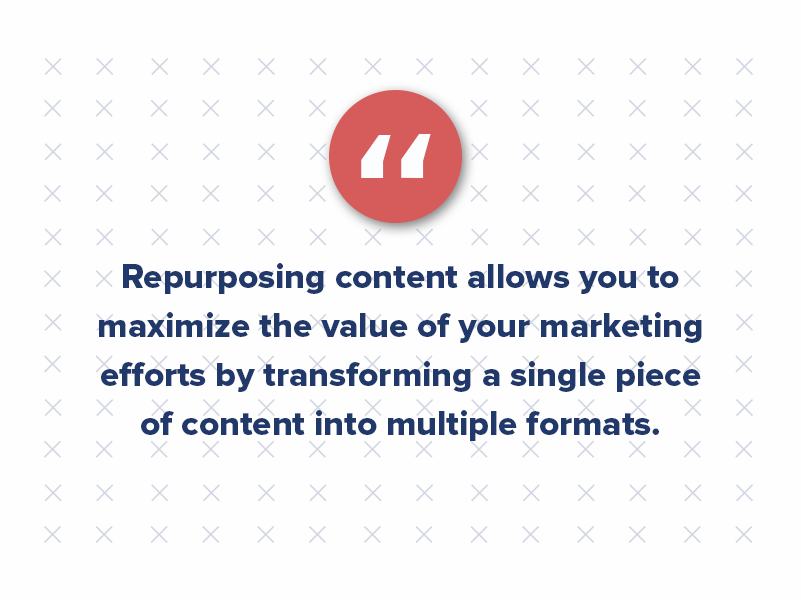
8. Maximize Reach with Content Repurposing
Repurposing content allows you to maximize the value of your marketing efforts by transforming a single piece of content into multiple formats. Vaibhav Kakkar, CEO of Digital Web Solutions, highlights how his team’s content repurposing strategy led to increased reach and engagement.
“We maximize the value of our content by transforming a single piece into multiple formats,” says Kakkar. This approach ensures that your core message reaches different audience segments, making your marketing strategies more efficient and impactful.
9. Personalize Your Email Marketing Campaigns
Personalization is key to effective email campaigns. Lauren Gast, Marketing Director at Truck Driver Institute, shares how personalized email campaigns have increased inquiries for their CDL training programs.
“It works because it creates a one-to-one and relevant relationship with the audience,” says Gast. By addressing the specific needs and interests of your audience, personalized emails can significantly boost engagement and conversion rates.
10. Showcase Customer Testimonials
Customer testimonials and case studies are powerful tools for building trust and credibility with potential clients. Tim Woda, Founder at White Peak, shares how leveraging customer testimonials led to an increase in leads and inquiries.
“Real-life success stories resonate with prospects far more than generic marketing messages,” says Woda. By showcasing the tangible benefits of your services through customer testimonials, you can convert leads into customers more effectively.
11. Produce Engaging Explainer Videos
Visual content, especially videos, is a highly effective way to communicate complex messages quickly and engagingly. Kevin Watts, President and Founder at Raincross, shares how an explainer video increased qualified leads by over 30% within the first month.
“Videos work because they can convey a complex message in a short, easy-to-understand format,” says Watts. Engaging visual content can capture the attention of your audience and drive them to take action.
12. Leverage Strategic Partnerships
Strategic partnerships allow you to tap into an established network and community, providing access to high-quality leads. Robert P. Dickey, President and CEO at AQ Marketing, shares how strategic partnerships have driven significant lead generation for his clients.
“Strategic partnerships work because you’re leveraging an established network and community that already trusts your partner,” says Dickey. By creating mutually beneficial partnerships, you can gain exposure to new audiences and drive organic growth.
13. Utilize User-Generated Content
User-generated content (UGC) adds authenticity to your marketing tactics by showcasing real customer experiences. Kam Talebi, CEO of Gigli, shares how utilizing UGC has improved their ROI and strengthened connections with customers.
“UGC is more effective than brand-generated content because it showcases the experiences that other people are having with our products,” says Talebi. Incorporating UGC into your marketing strategy can build trust and engagement with your audience.
14. Organize Industry-Specific Events
Industry-specific events directly engage your target market, making them a highly effective marketing tactic. Amar Ghose, CEO of ZenMaid, shares how organizing the “Maid Summit” significantly boosted brand awareness and generated high-quality leads.
“By bringing people together and providing valuable content, we not only increased our brand visibility but also maintained a steady flow of leads,” says Ghose. Organizing events allows you to connect with your audience on a personal level and establish your brand as a leader in your industry.
15. Tailor Marketing to Generational Segments
Understanding the unique preferences of different generational segments is crucial for crafting personalized marketing strategies. Farnam Elyasof, Founder of Flex Suits, shares how tailoring campaigns to Millennials and Gen X has optimized engagement and boosted leads.
“Being aware of generational nuances ensures that you are using the right marketing strategies to boost your leads and revenue,” says Elyasof. By addressing the specific needs and preferences of each generation, you can create more effective and relevant campaigns.
16. Offer Referral Incentives
Referral incentives are a cost-effective way to amplify word-of-mouth marketing and drive organic growth. John Cammidge, Handyman at Handyman John, shares how offering a 10% discount for referrals significantly boosted revenue and client loyalty.
“Referral incentives leverage trust — clients trust their friends’ recommendations,” says Cammidge. By rewarding existing clients for referring new customers, you can create a cycle of consistent growth and client retention.
Championing Success Through Strategic Marketing Tactics
These marketing tactics, championed by industry thought leaders, demonstrate the power of strategic, personalized, and value-driven approaches. Whether through cause marketing, personalized email campaigns, or organizing industry events, these marketing strategy examples have proven their effectiveness in driving results across various sectors. With these marketing tactics, you can enhance engagement, build trust, and achieve long-term success for your organization.

Content Marketing: Your Multifamily Brand’s Secret Weapon in Tough Times
Let’s be honest — everyone’s talking about content marketing these days, but it’s not just another buzzword when it comes to multifamily. It’s your secret weapon for building an outstanding multifamily brand identity.
Sure, multifamily inbound marketing isn’t exactly groundbreaking, but here’s the thing: it’s often misunderstood. It’s not just about chasing leads — it’s about crafting a strong online presence, boosting brand awareness, and making your property the go-to choice in a crowded market.
Why Content Marketing Should Be Top Priority (Even When Budgets Are Tight)
In a year where the mantra is “stay alive until 2025,” it’s tempting to pull back on marketing budgets and wait for the market to bounce back. However, cutting content marketing might be a mistake that could cost you more in the long run. Inbound marketing remains one of the most cost-effective strategies out there, offering a high return on investment even when budgets are tight.
Consider this: content marketing campaigns cost 62% less to launch and maintain than other marketing campaigns. Despite the lower cost, the impact is significant.
For instance, 51% of content consumption comes from organic search, meaning your content can continue to draw in traffic and build brand awareness without requiring constant ad spend. Additionally, content marketing is responsible for increasing lead generation according to 74% of companies — proof that it’s an investment worth maintaining.
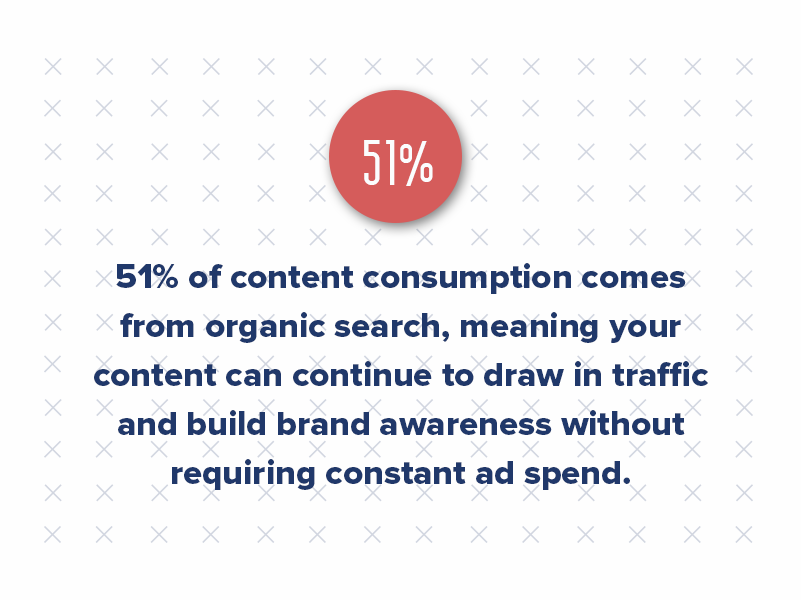
Even in tough economic times, multifamily inbound marketing provides a sustainable way to stay visible and relevant. Over a third of businesses have recognized this, allocating 10% to 29% of their budget to content marketing. High-quality content is also the most effective SEO strategy for 59% of B2C marketers, underscoring its importance in driving organic traffic and improving search engine rankings.
Moreover, the role of inbound marketing extends beyond just budget efficiency. It’s about maintaining your brand’s presence in a competitive market. With 78% of people using social media as their primary way to find information on brands, having a consistent content strategy helps ensure that your brand remains top of mind for potential customers. And businesses that integrate link-building strategies with their content marketing report a 45% greater success rate, highlighting how these efforts can amplify your overall marketing effectiveness.
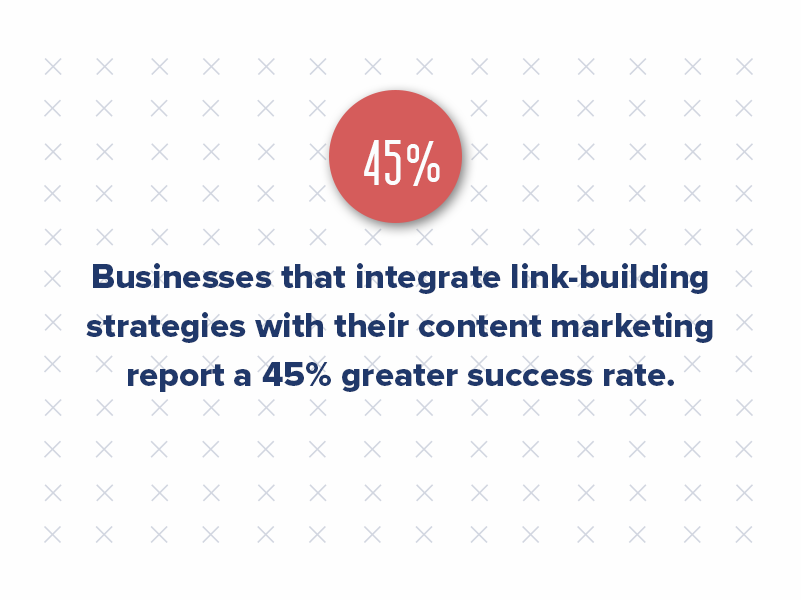
In-person events, webinars, email campaigns, organic social media platforms, and blogs are among the top-performing content marketing channels. Whether hosting a webinar or crafting a blog post, each piece of content contributes to your brand’s overall visibility and credibility.
So, while the market might be uncertain now, maintaining or doubling down on your inbound marketing efforts can position your brand for tremendous success when the economy rebounds.
Here are some additional tips for an effective content marketing strategy:
1. Start a Consistent Blogging Strategy
Blogging is a foundational element of inbound marketing that is crucial to building your brand identity. A well-maintained blog can significantly enhance your property’s visibility online. Here are some compelling reasons why:
- Increased Visibility: Websites with blogs have 434% more indexed pages, meaning they are more likely to appear in search engine results.
- Enhanced Trust: Blogs are rated as the fifth most trusted source for accurate online information.
- Brand Authority: Regular blogging helps establish your property as an authority in the multifamily industry, making it a go-to resource for potential residents.
Starting a consistent blogging strategy involves identifying the topics that matter most to your target audience and delivering content that addresses their needs and interests. This approach keeps your website active and helps build trust and credibility, essential components of a strong brand.
2. Tell Your Multifamily Brand Story
Every brand has a story to tell, and your multifamily property is no different. Your brand story is the narrative that encompasses your property’s values, mission, and the unique lifestyle it offers. Blogging and content creation are potent tools for sharing this story across various platforms, helping potential residents connect with your brand on a deeper level.
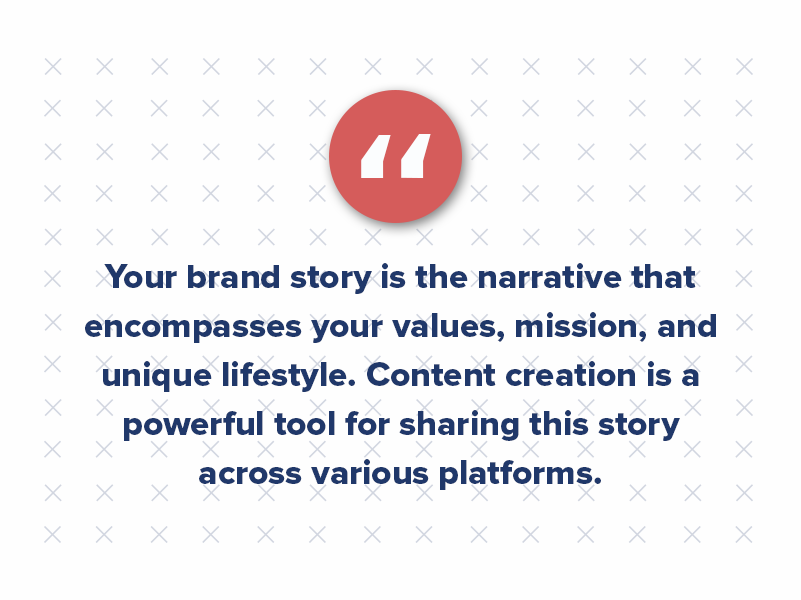
To effectively tell your brand story, consider it more than just marketing. It’s about creating an editorial vision that aligns with your brand’s identity. Whether through blog posts, social media updates, or video content, your storytelling should reflect the essence of your property and the experience it offers. This approach humanizes your brand and fosters a strong emotional connection with your audience.
3. Create Content That Resonates
Creating content that truly resonates with your audience requires a deep understanding of who they are and what they need. This is where a persona-driven strategy comes into play. By developing detailed resident personas, you can tailor your content to address your target audience’s specific pain points, desires, and lifestyle choices.
When creating content, it’s important to consider the entire customer journey. This involves crafting content that speaks to potential residents at every stage — from those just beginning their apartment search to those ready to sign a lease. By addressing the different stages of the renter’s journey — Awareness, Consideration, and Decision — you ensure that your content remains relevant and valuable, helping to build a lasting relationship with your audience.
4. Adopt a Persona-Driven Strategy
Understanding your audience is key to creating content that effectively builds your brand. A persona-driven strategy allows you to focus on your target residents’ specific needs and interests, ensuring that your content is always relevant and engaging.
Instead of trying to cover everything about your property, focus on what matters most to your audience. For example, if your target residents value sustainability, create content highlighting your property’s eco-friendly features. If your audience is primarily young professionals, focus on content that speaks to your property’s convenience and lifestyle benefits.
This targeted approach strengthens your multifamily brand identity and positions your property as the ideal choice for your target audience.
5. Maintain Consistency Across Platforms
Consistency is key to maintaining a robust multifamily brand identity. Whether it’s the tone of your blog posts, the imagery used in your social media, or the messaging on your website, everything should align with your brand’s identity. This uniformity ensures that your audience receives a cohesive message, reinforcing your brand’s presence and making it easily recognizable.
Utilizing tools like AMP Studio collateral templates can help maintain this consistency, allowing you to streamline your branding efforts across various channels. From floorplan sheets and brochures to email signatures and business cards, every piece of content should reflect your brand’s values and identity.
Why Outsource Your Content Marketing?
Outsourcing content marketing isn’t just a trend — it’s a strategic move that nearly half of all businesses embrace. In fact, 48% of content marketing is now handled by agencies or third-party companies. This approach allows businesses to leverage specialized expertise, particularly in graphic design, video production, and copywriting.
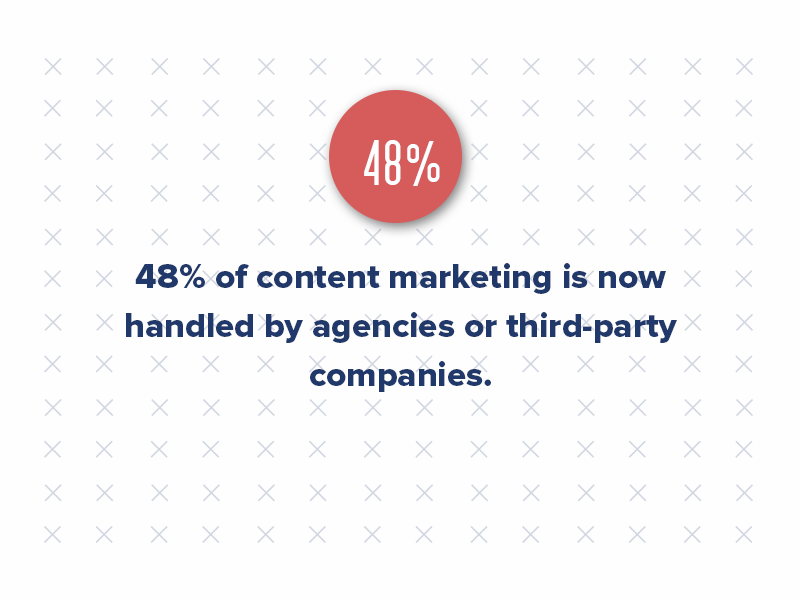
By outsourcing, you’re not just delegating tasks; you’re investing in the quality and effectiveness of your content. Consider this: 47% of outsourcing efforts focus on graphic design, ensuring that visuals are eye-catching and aligned with your multifamily brand identity. Meanwhile, 43% of businesses turn to experts for video design and animation, adding dynamic, engaging content to their marketing mix. And when it comes to articulating your brand’s message, 37% of content marketing efforts rely on professional copywriters to craft compelling narratives.
Outsourcing these creative tasks to an agency like Criterion.B can free up your time while ensuring your content is crafted with the expertise needed to resonate with your audience truly. With a team that understands the nuances of the multifamily market, we can help you build and maintain a strong, cohesive multifamily brand identity that stands out in a competitive landscape.
Make Your Brand Memorable, Not Just Noticeable
Think of multifamily inbound marketing as the cornerstone of your brand’s identity. It’s not just about getting noticed — it’s about making sure people remember you for all the right reasons. By staying consistent, you’re not just building a brand; you’re creating a lasting impression that keeps your property top of mind.
In a sea of options, being the property that stands out isn’t just nice — it’s necessary. So, invest in your content, keep it authentic, and watch as your brand is not only recognized but respected.


